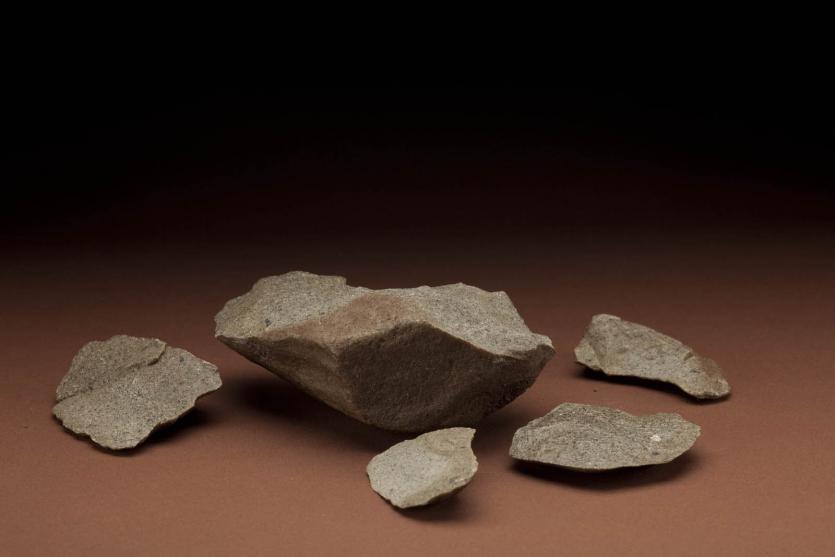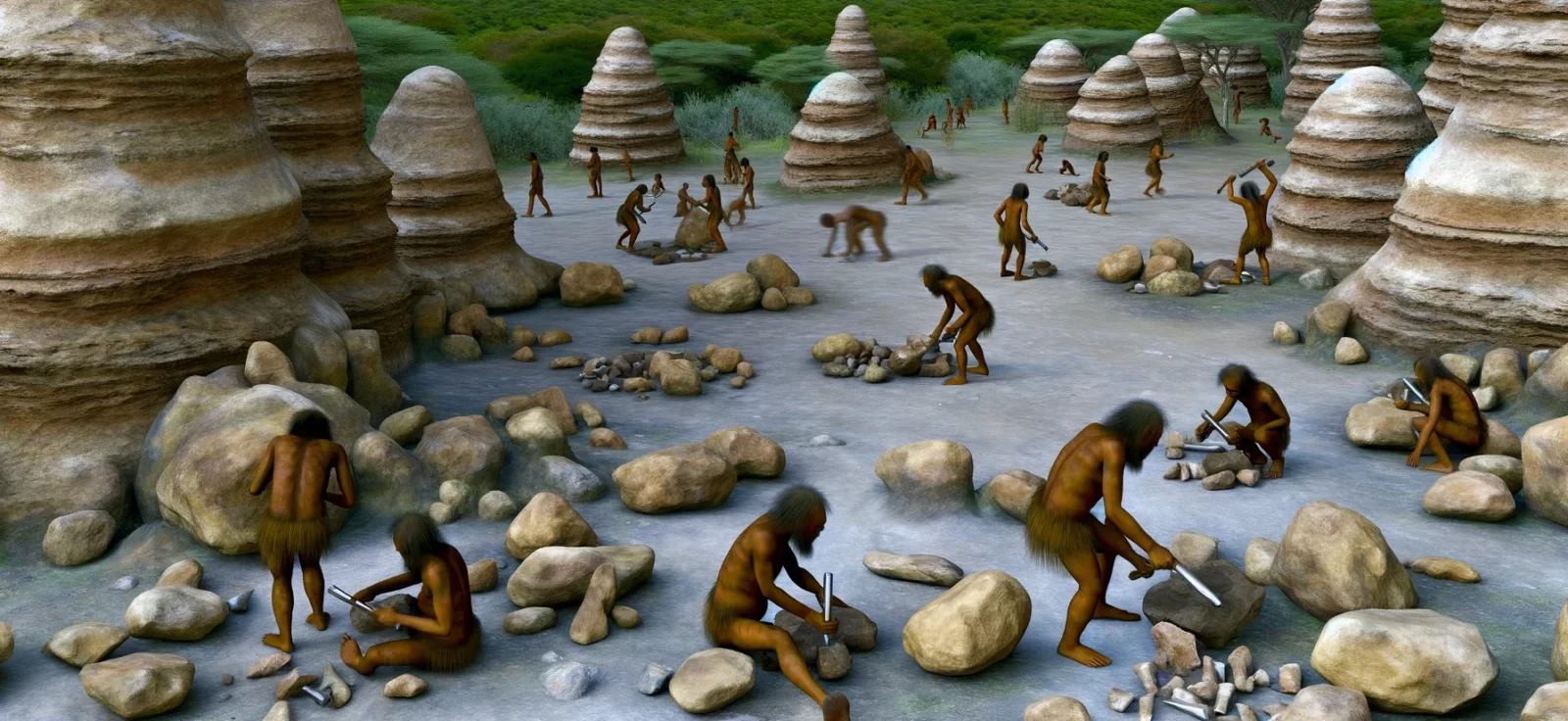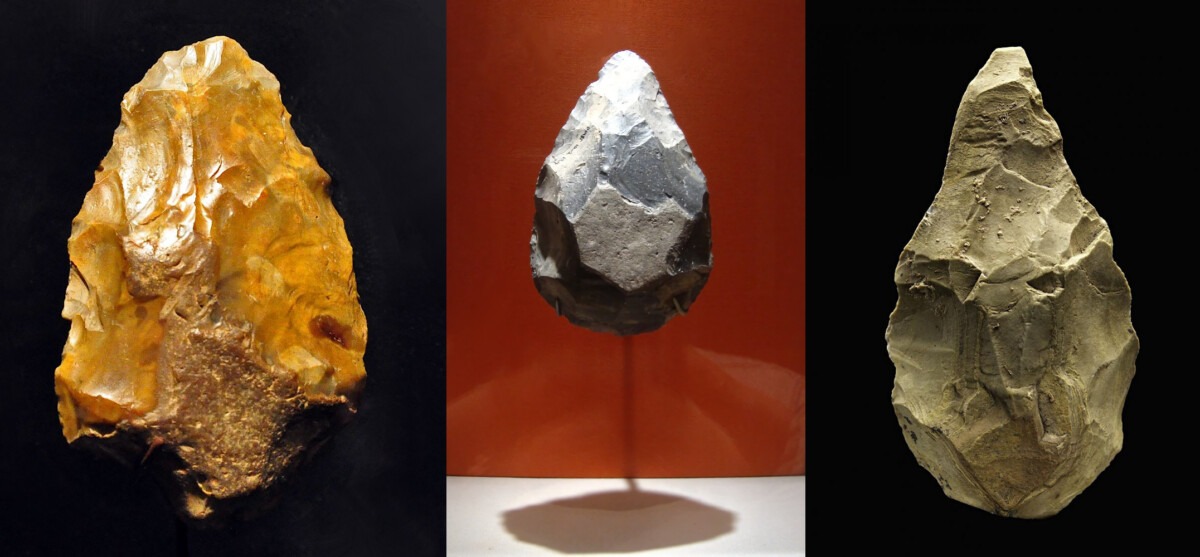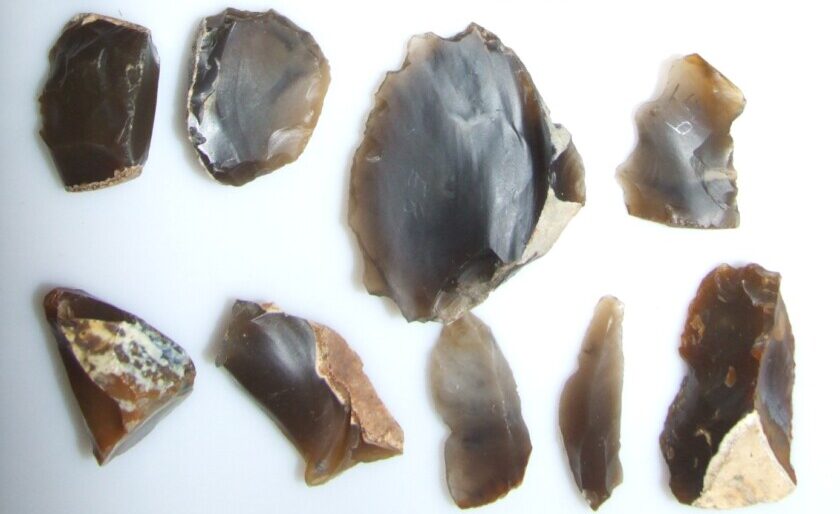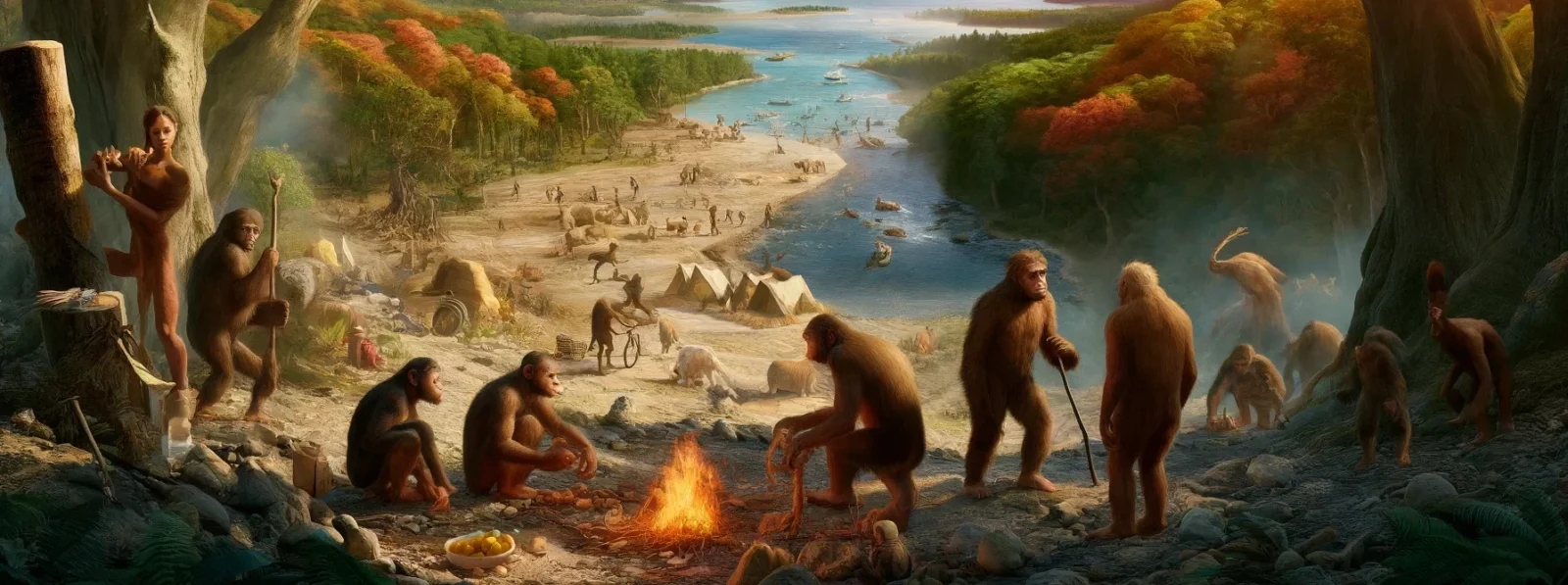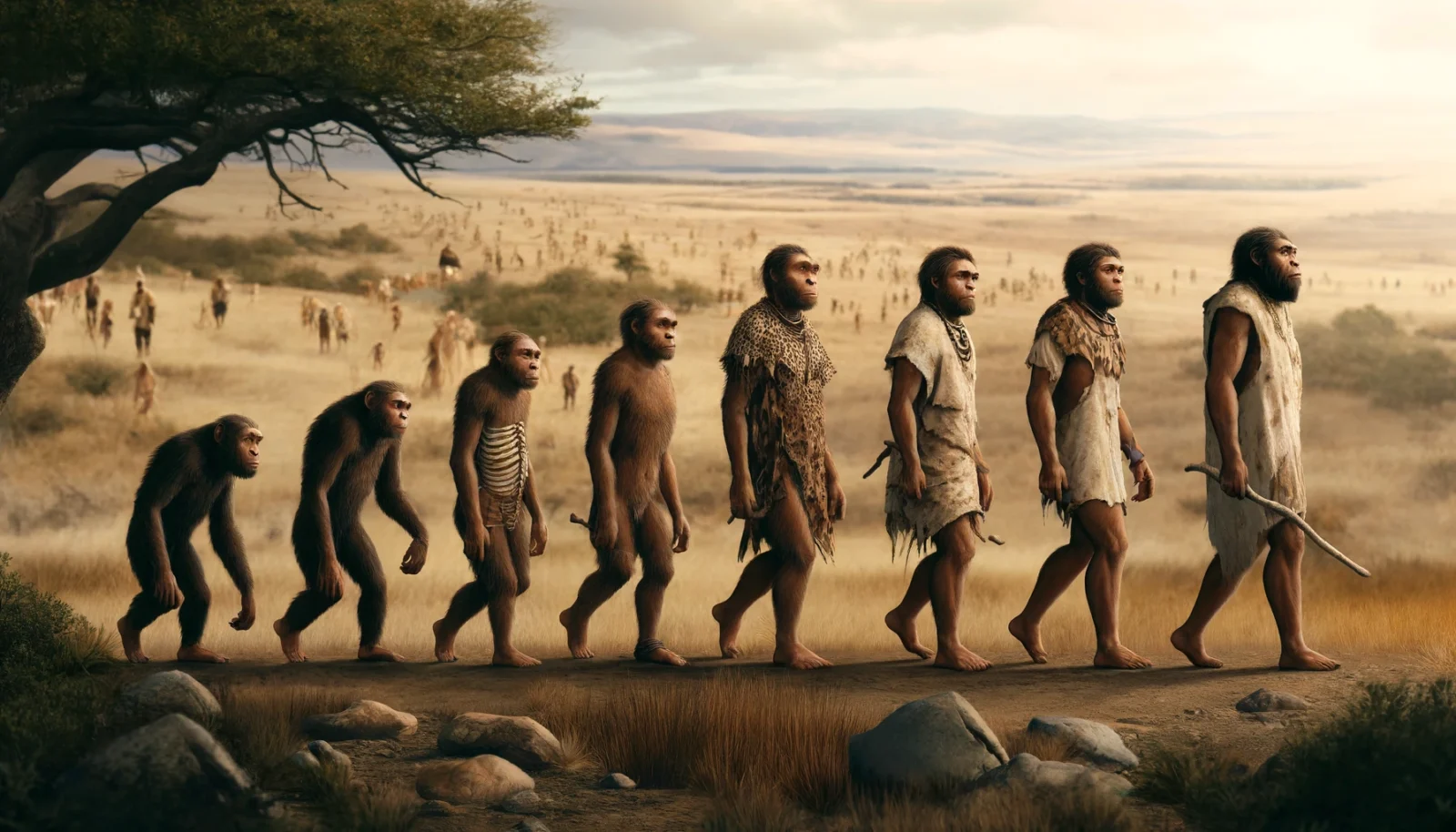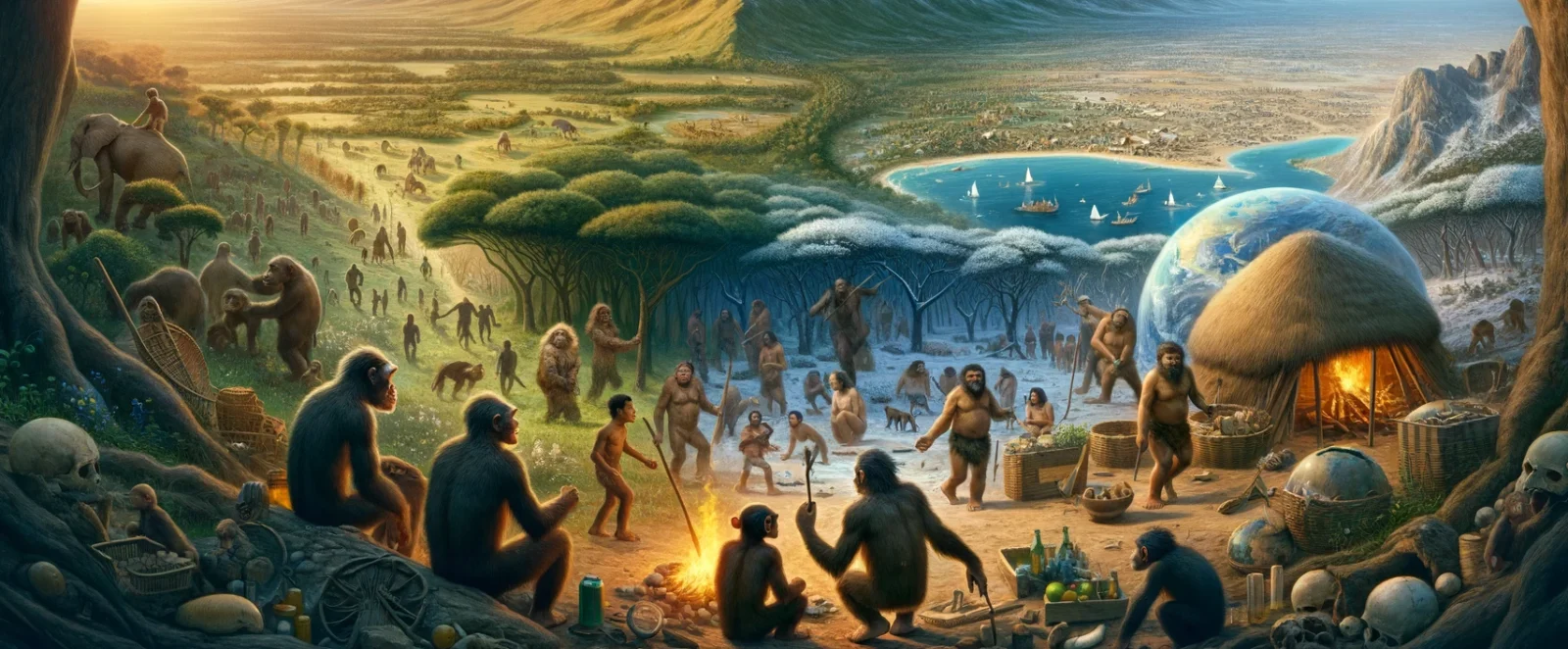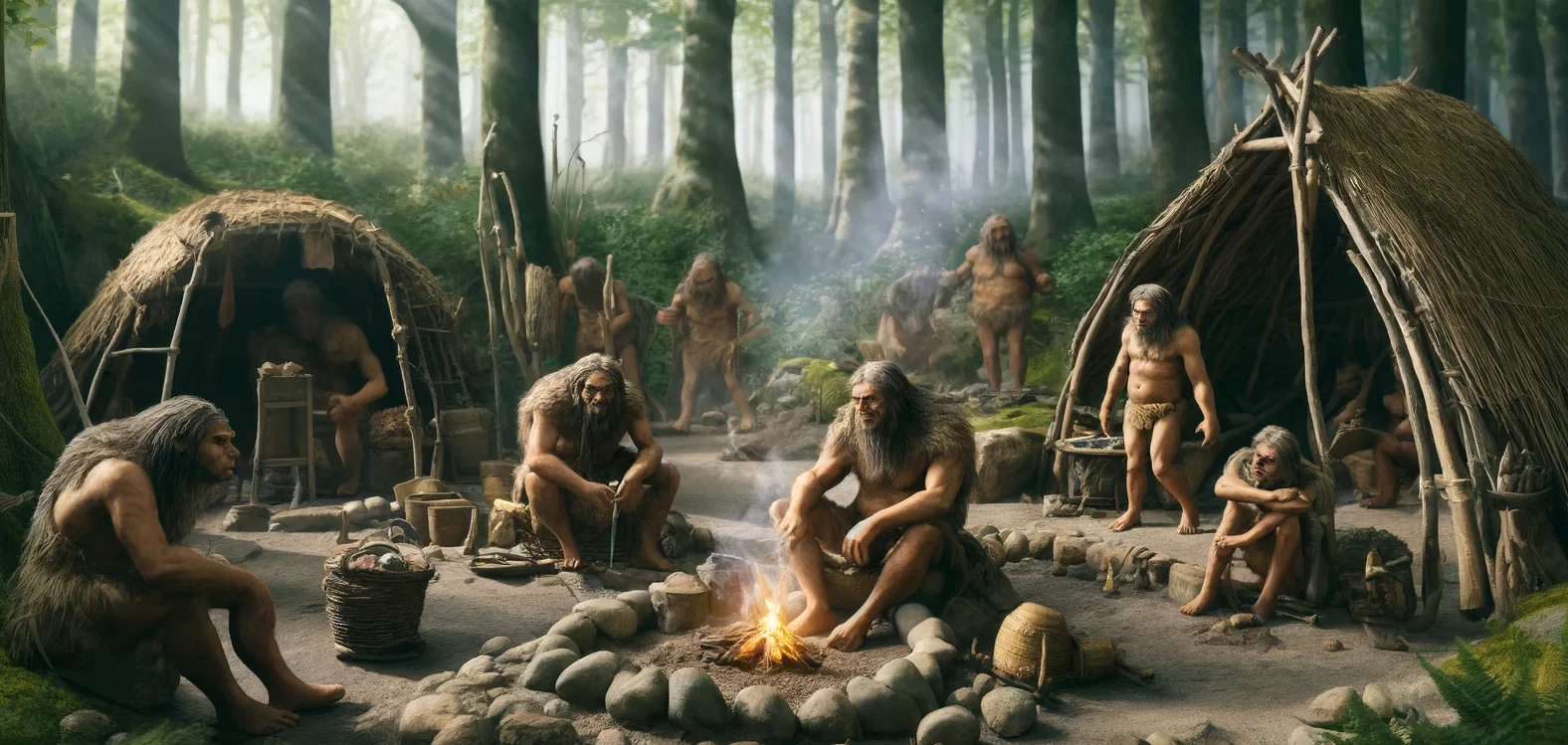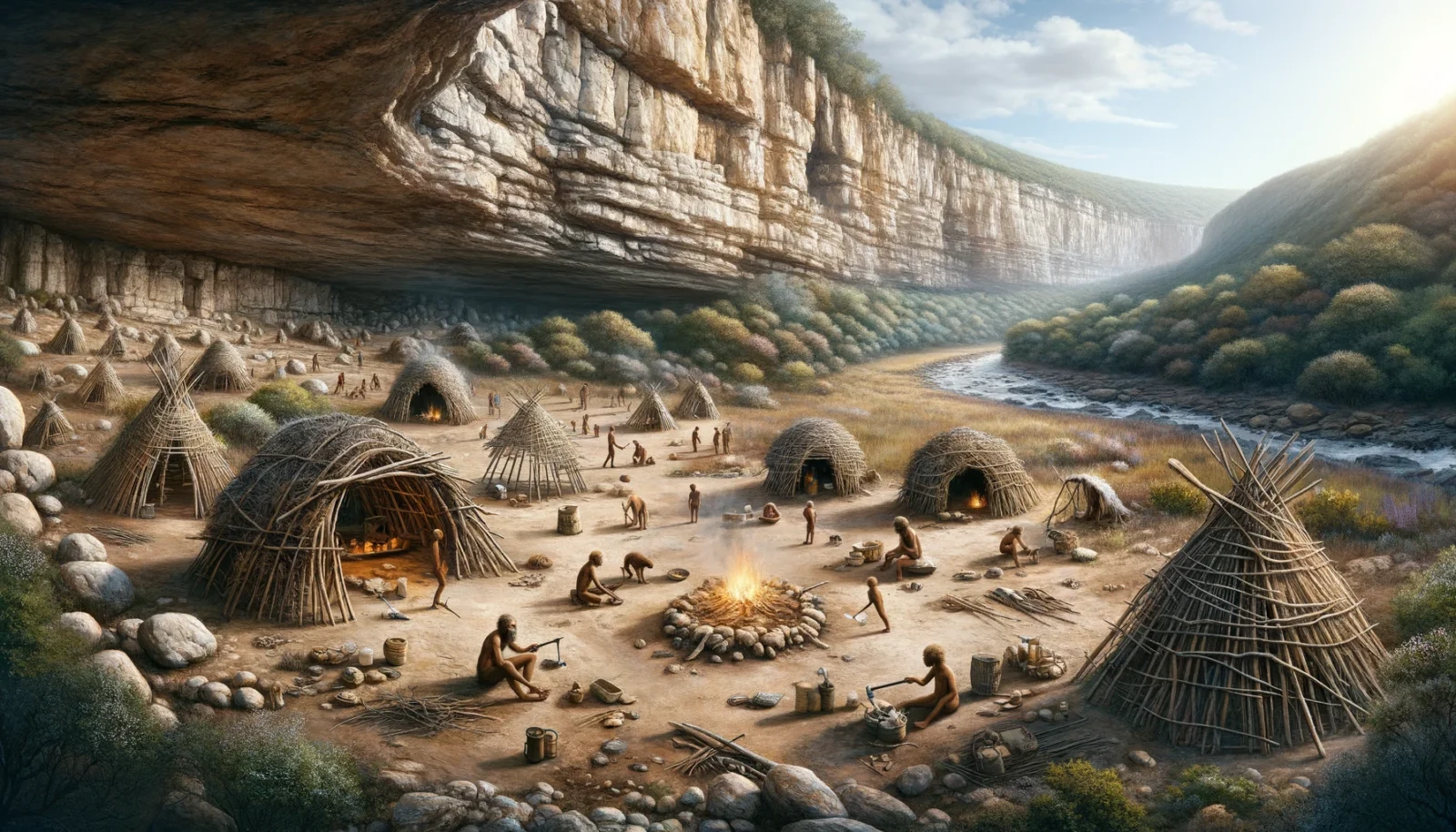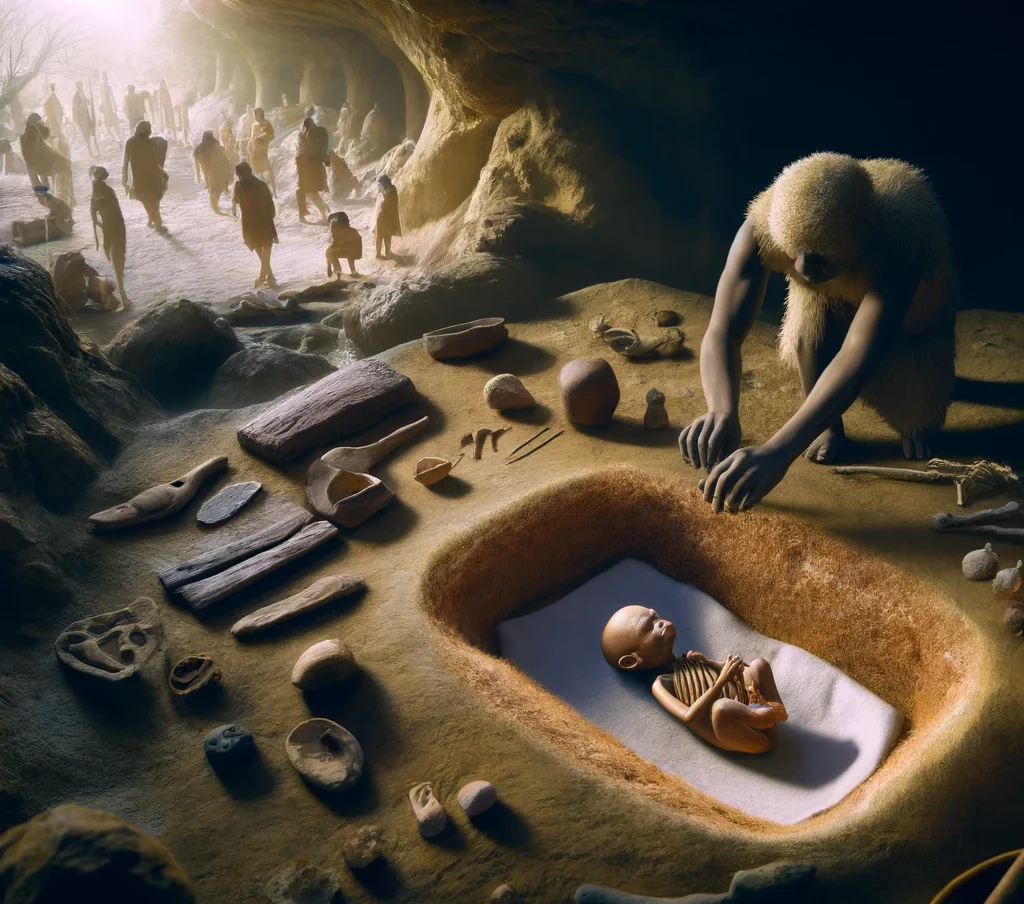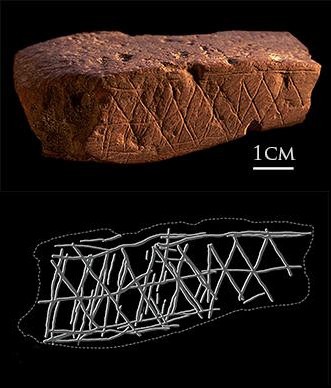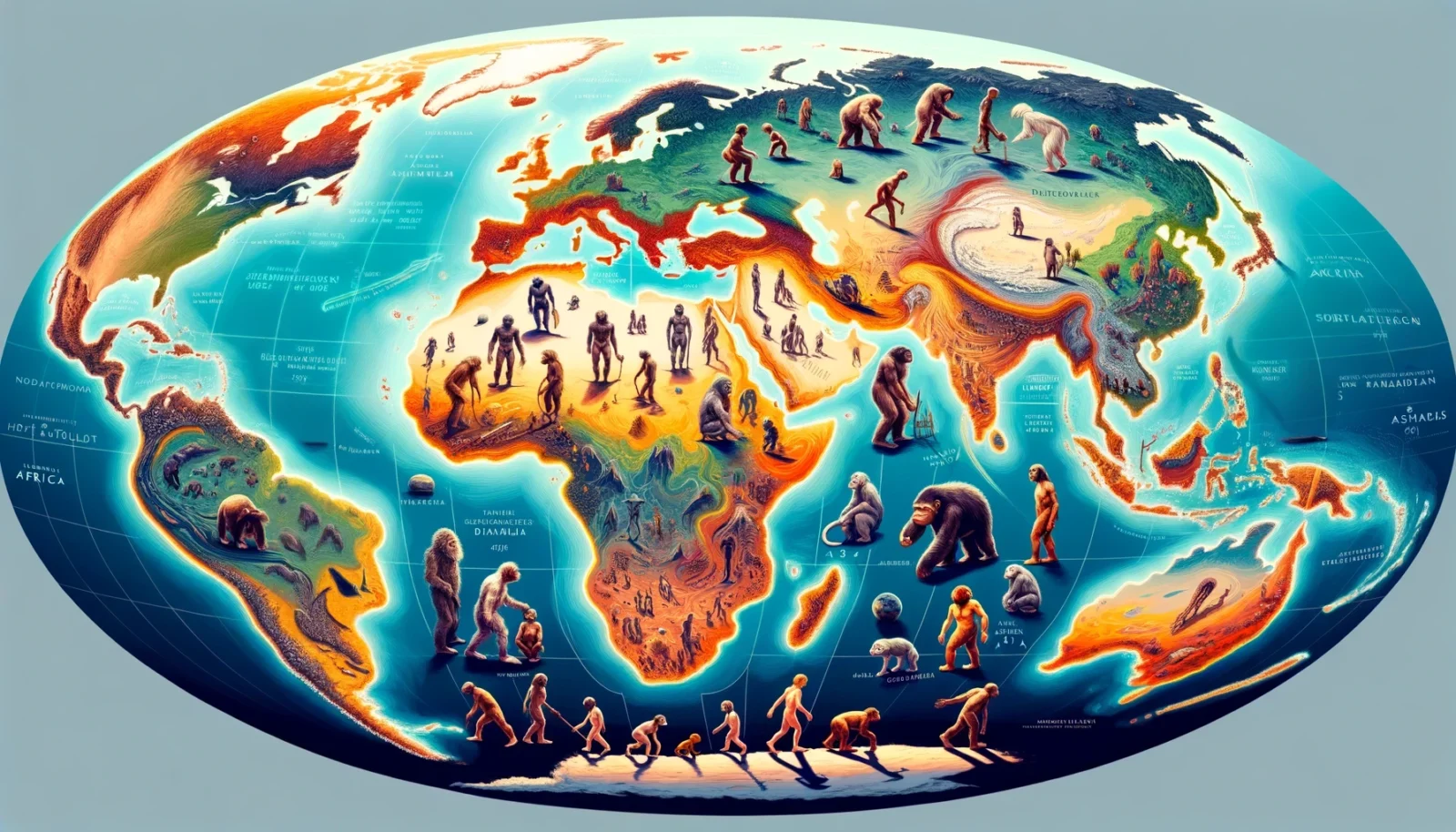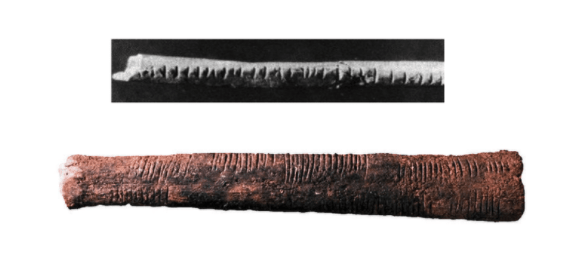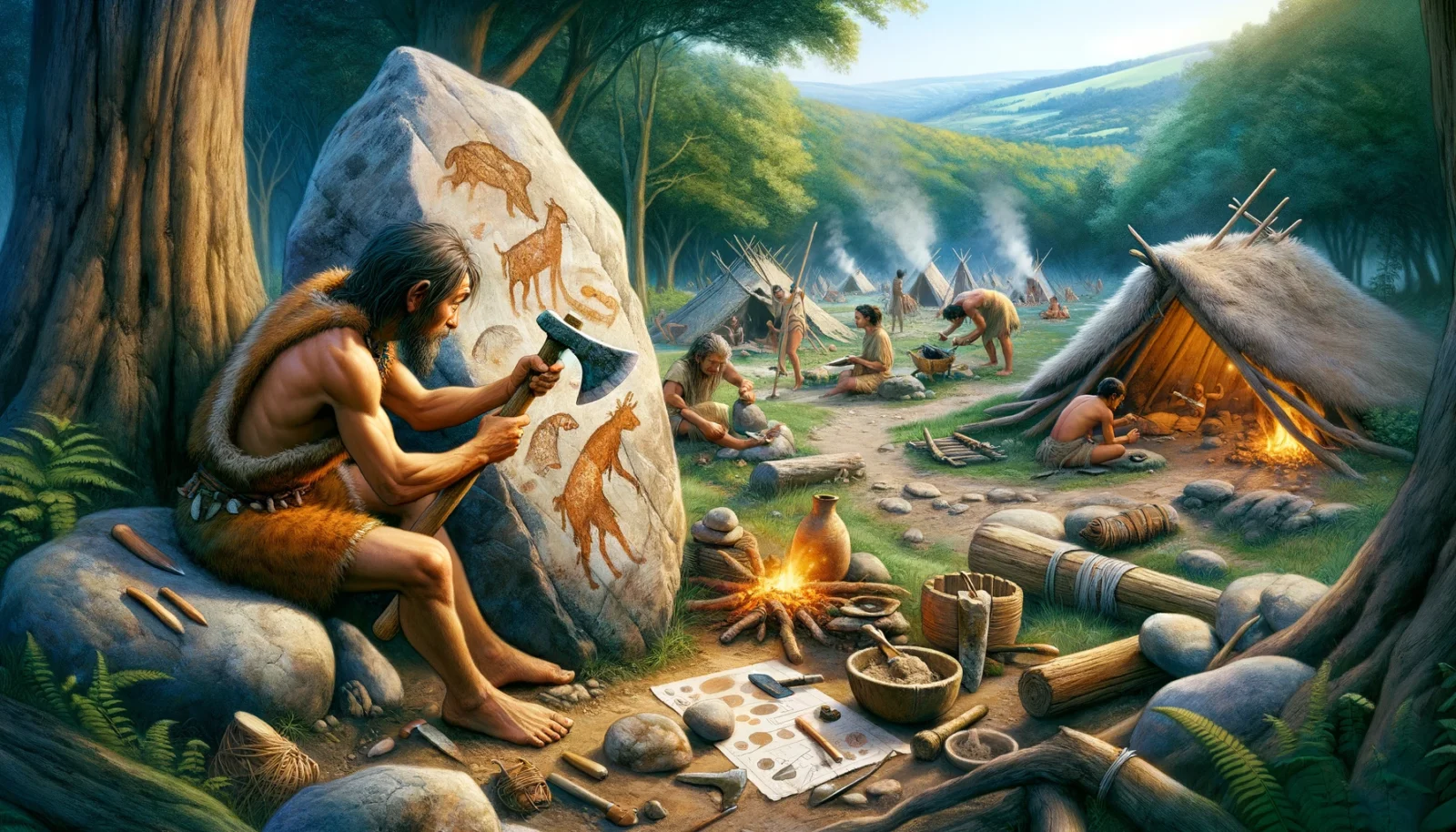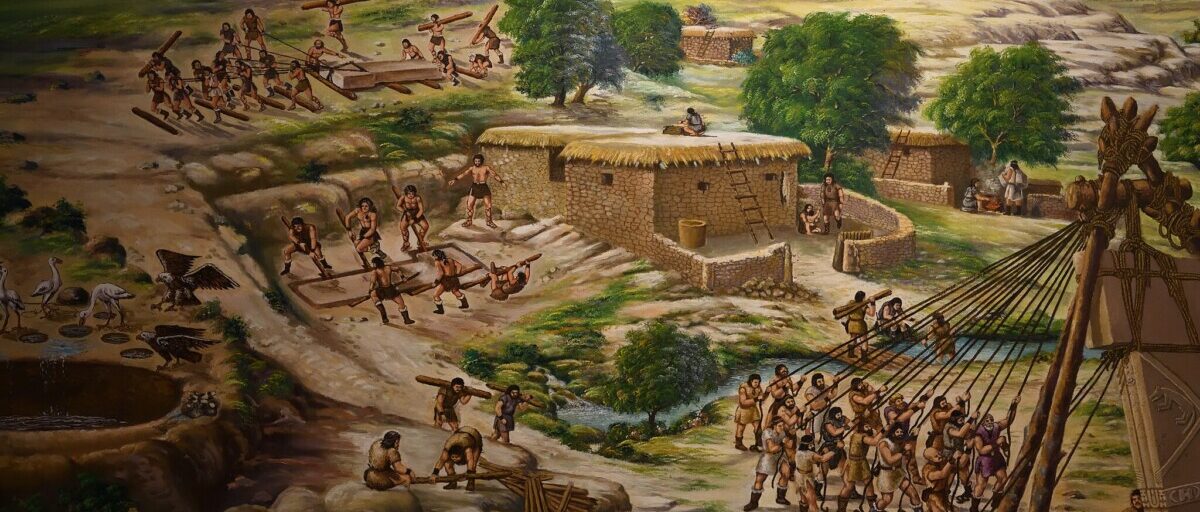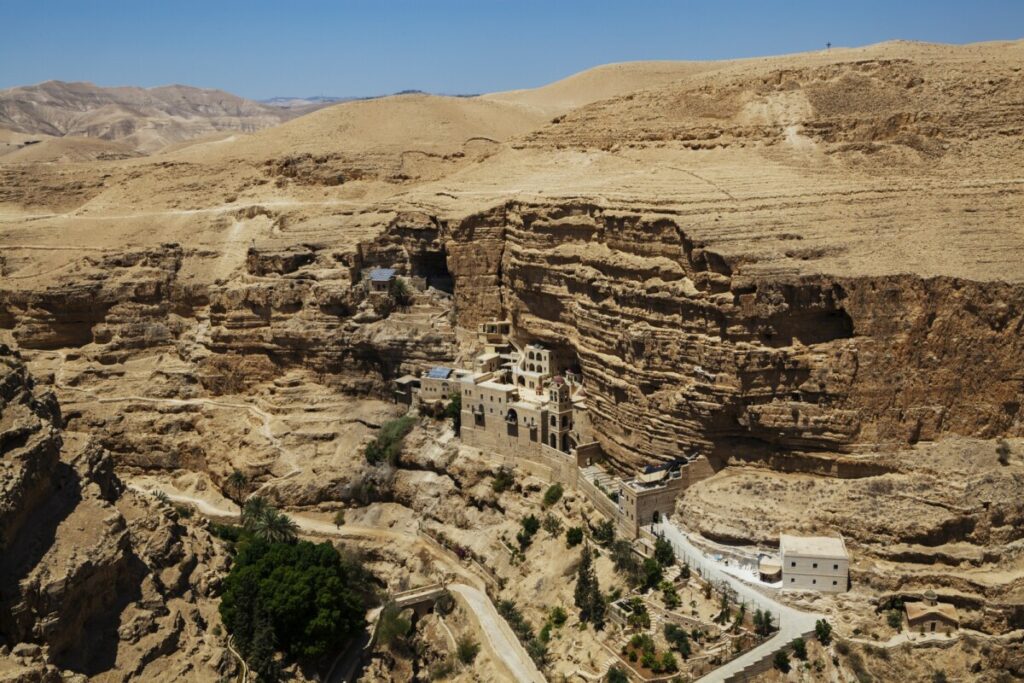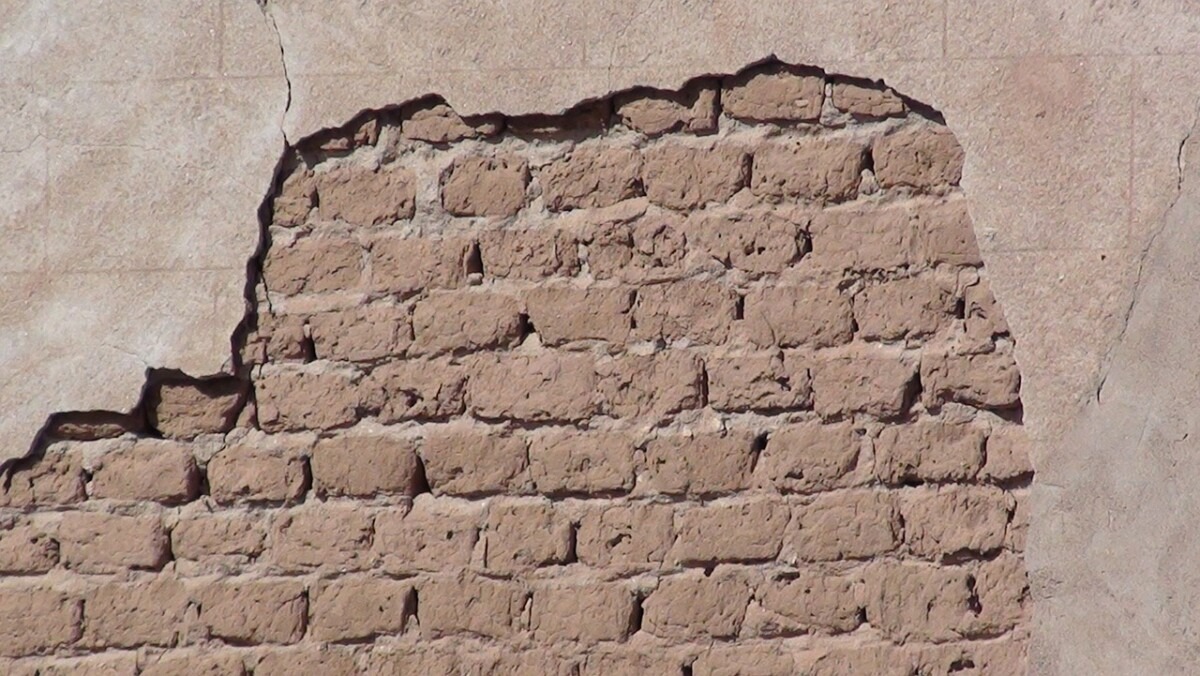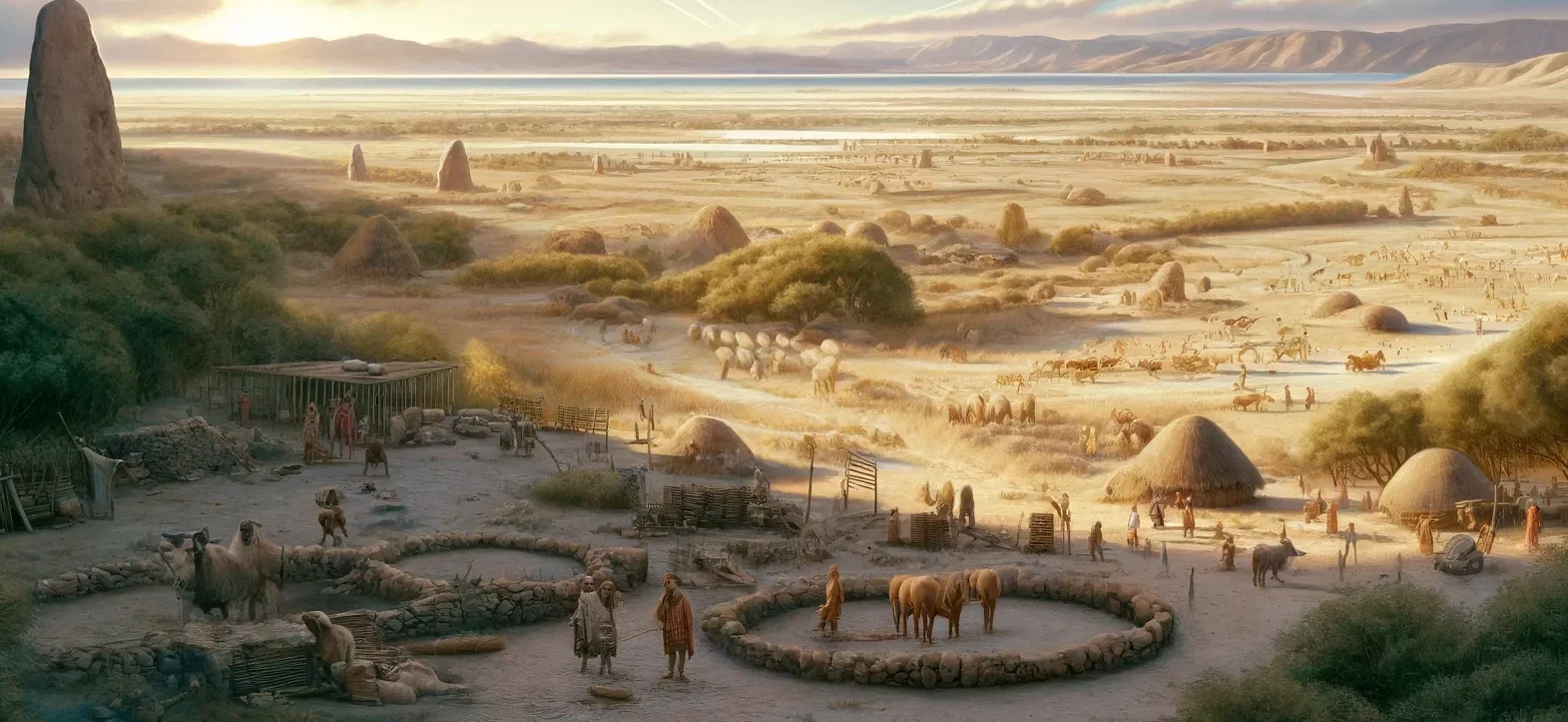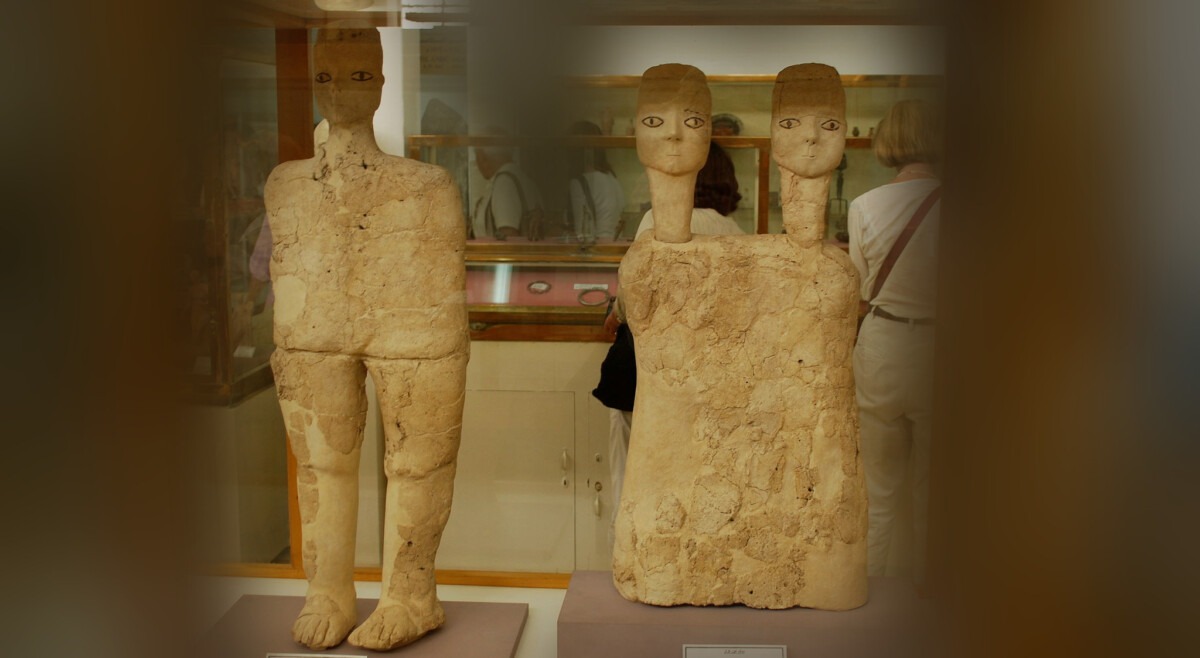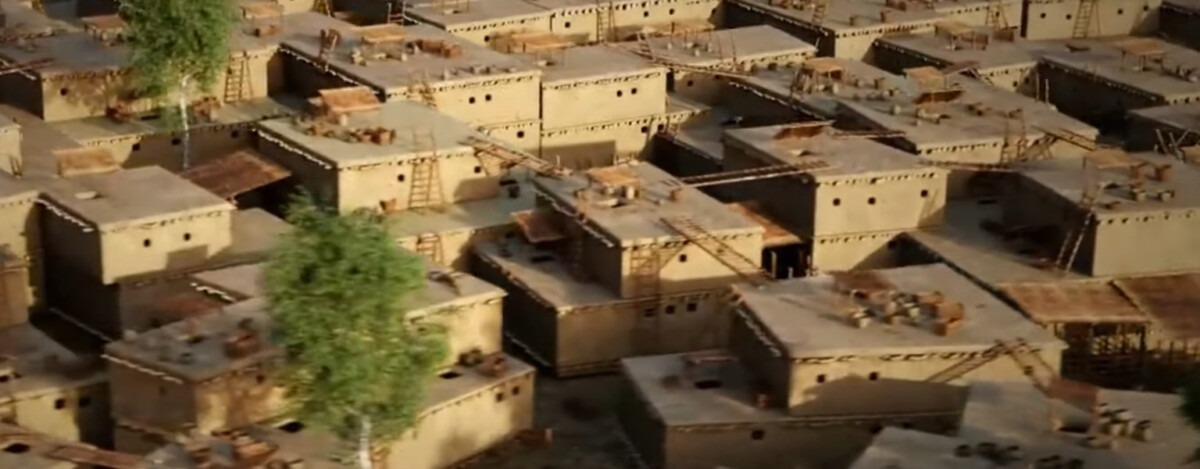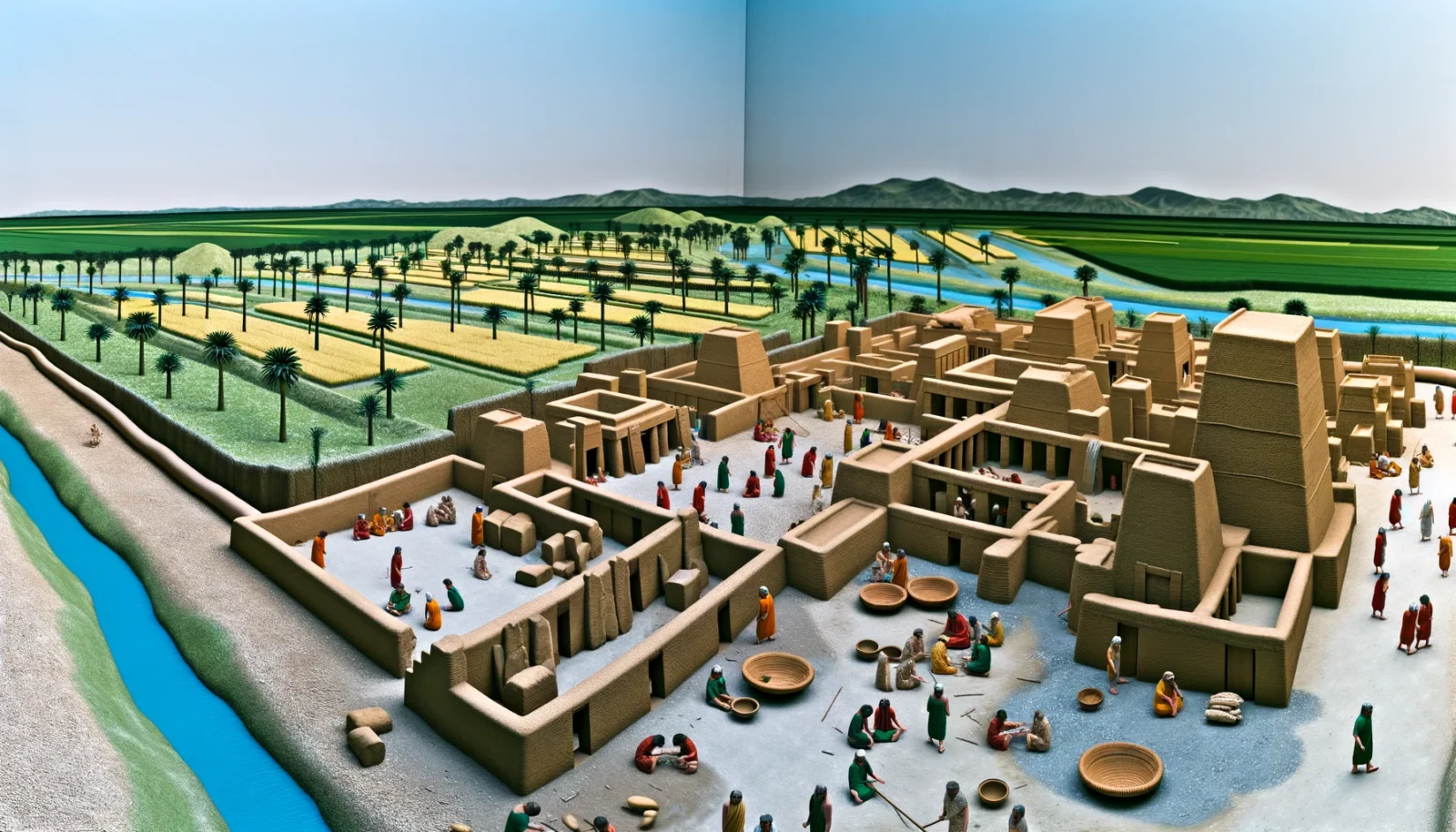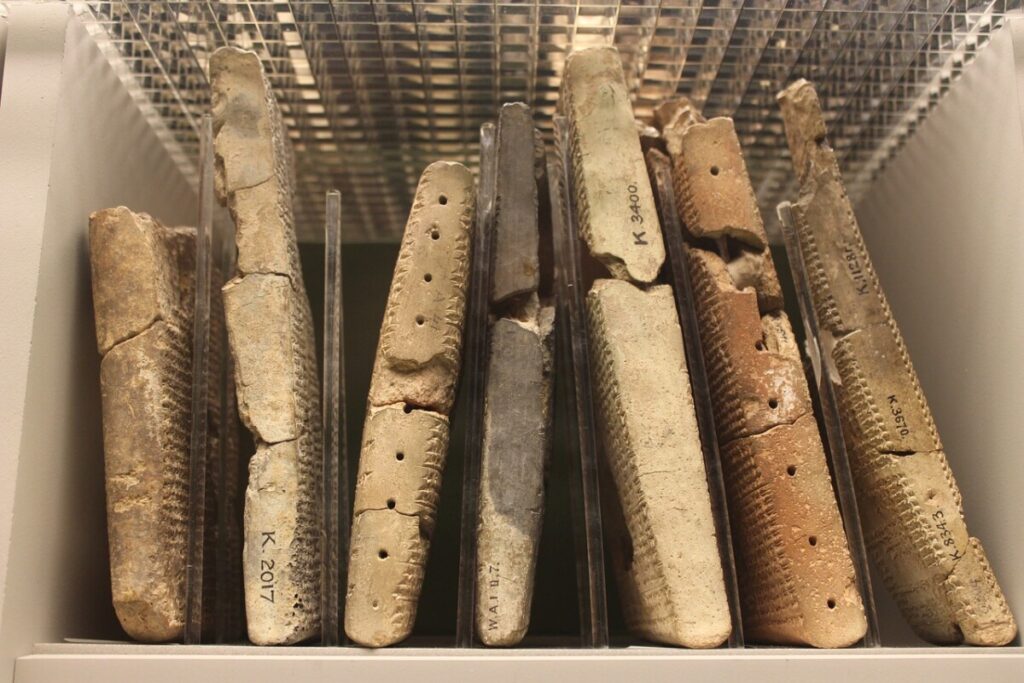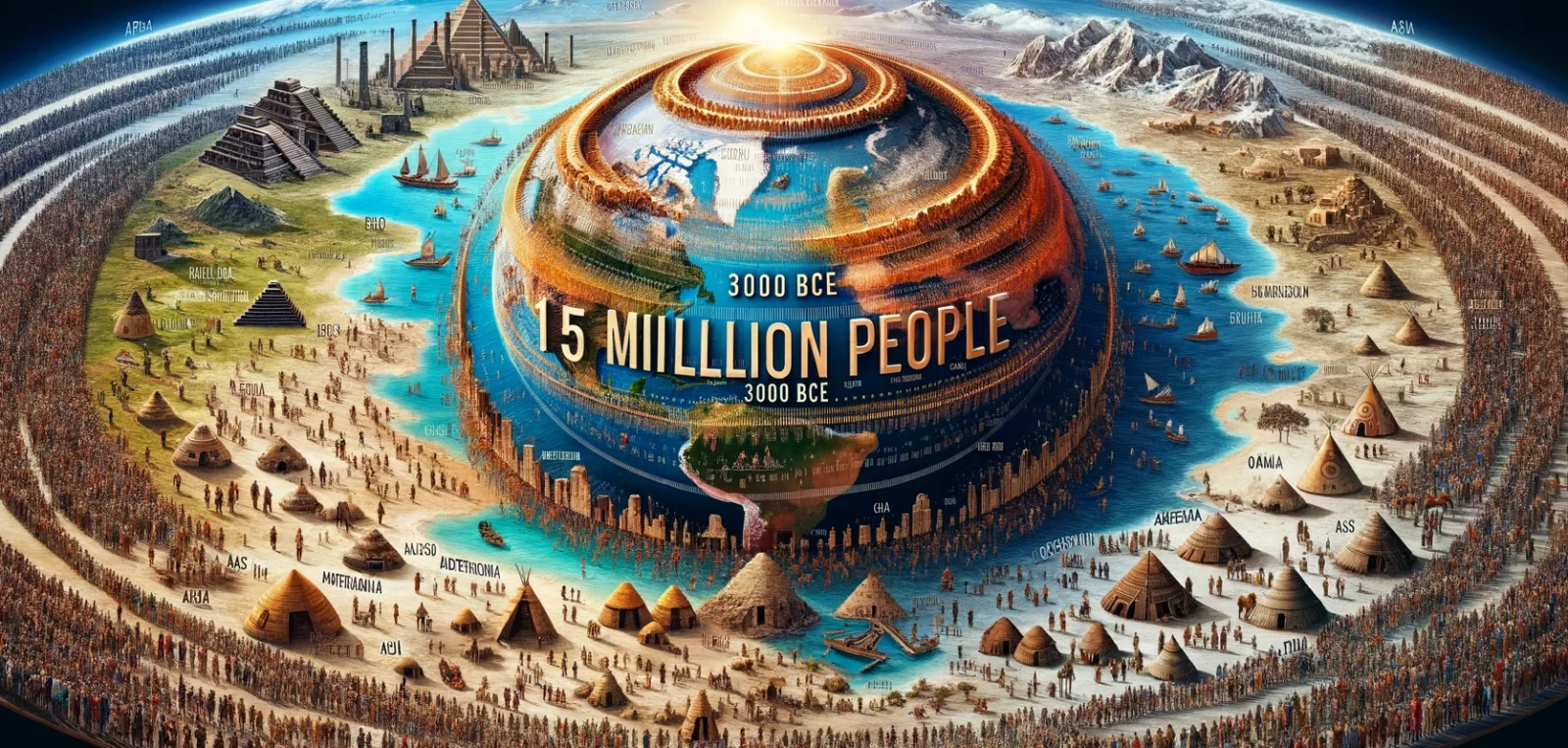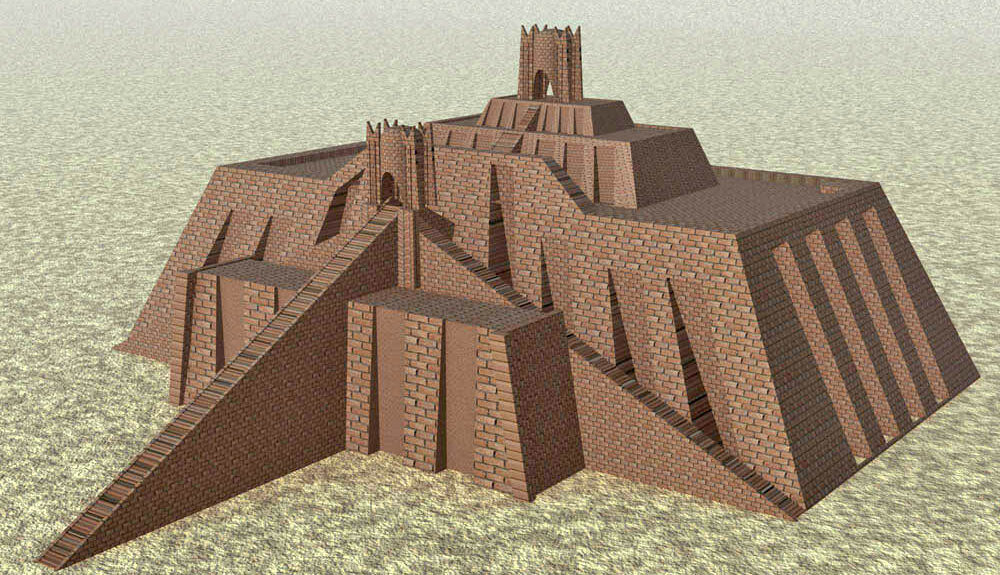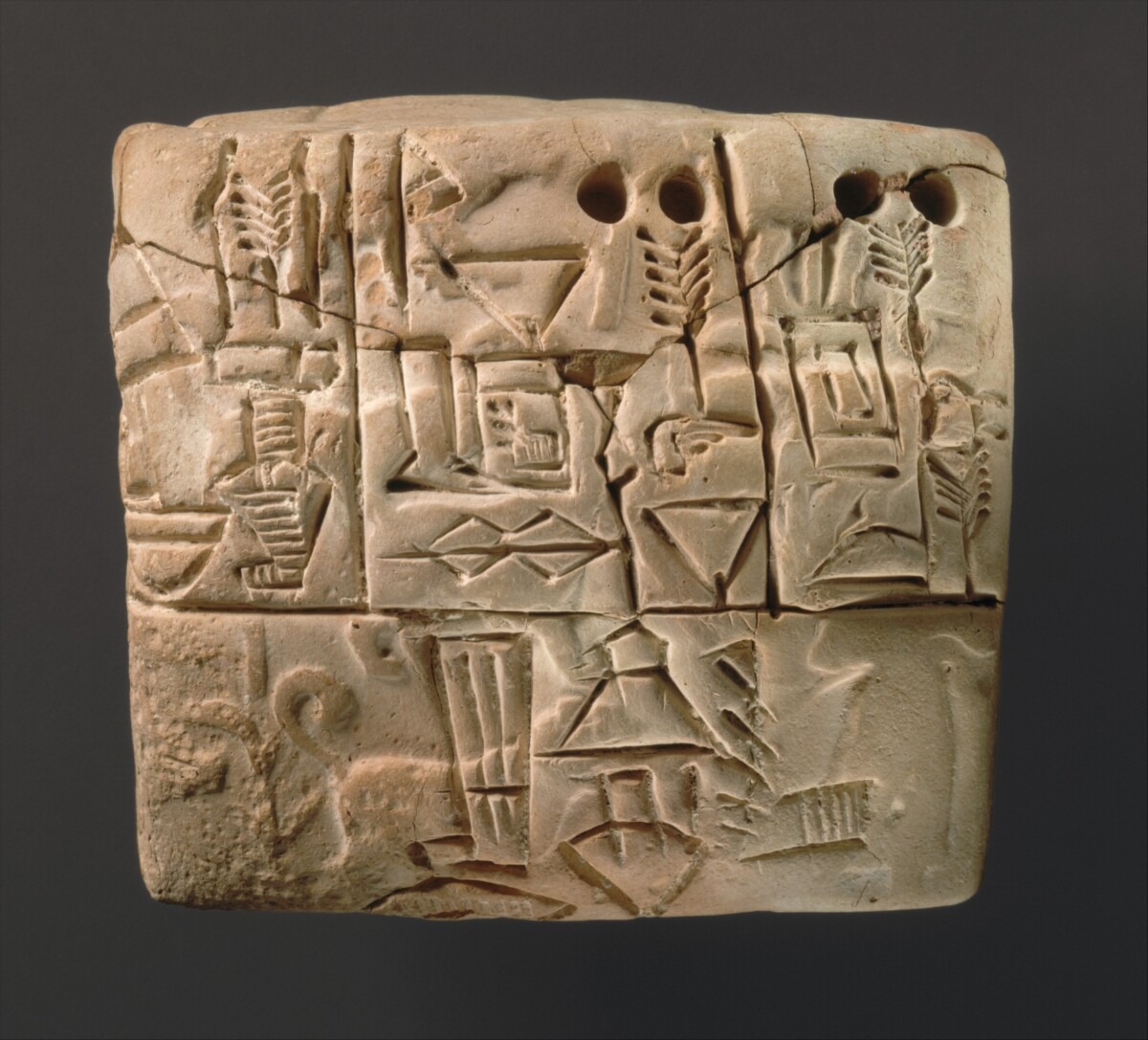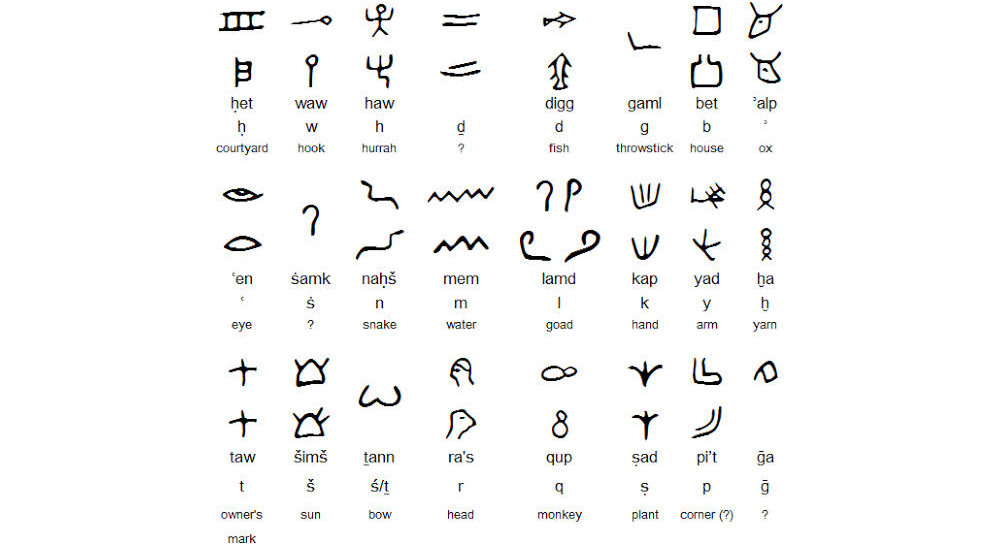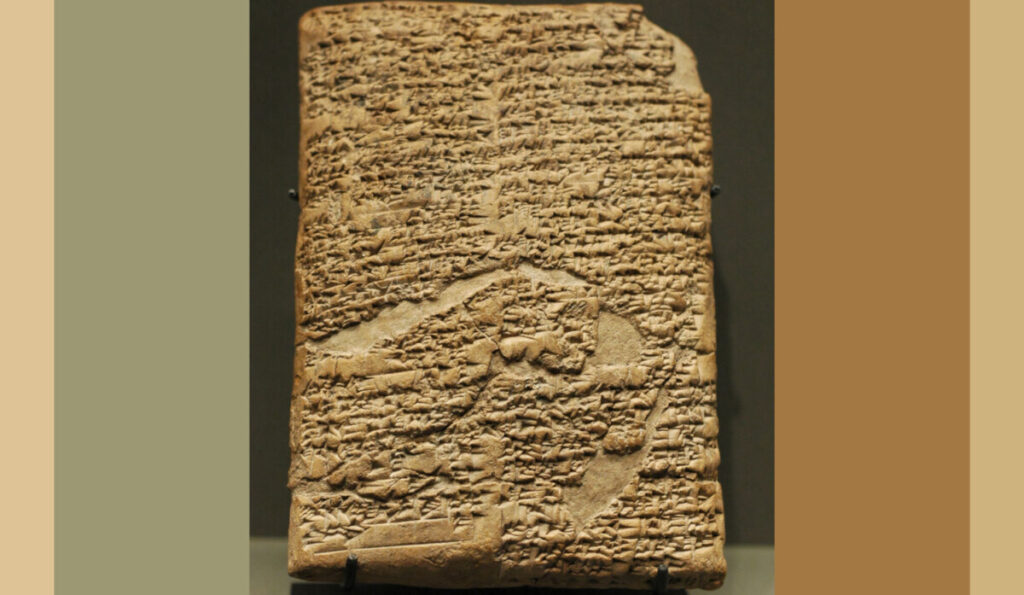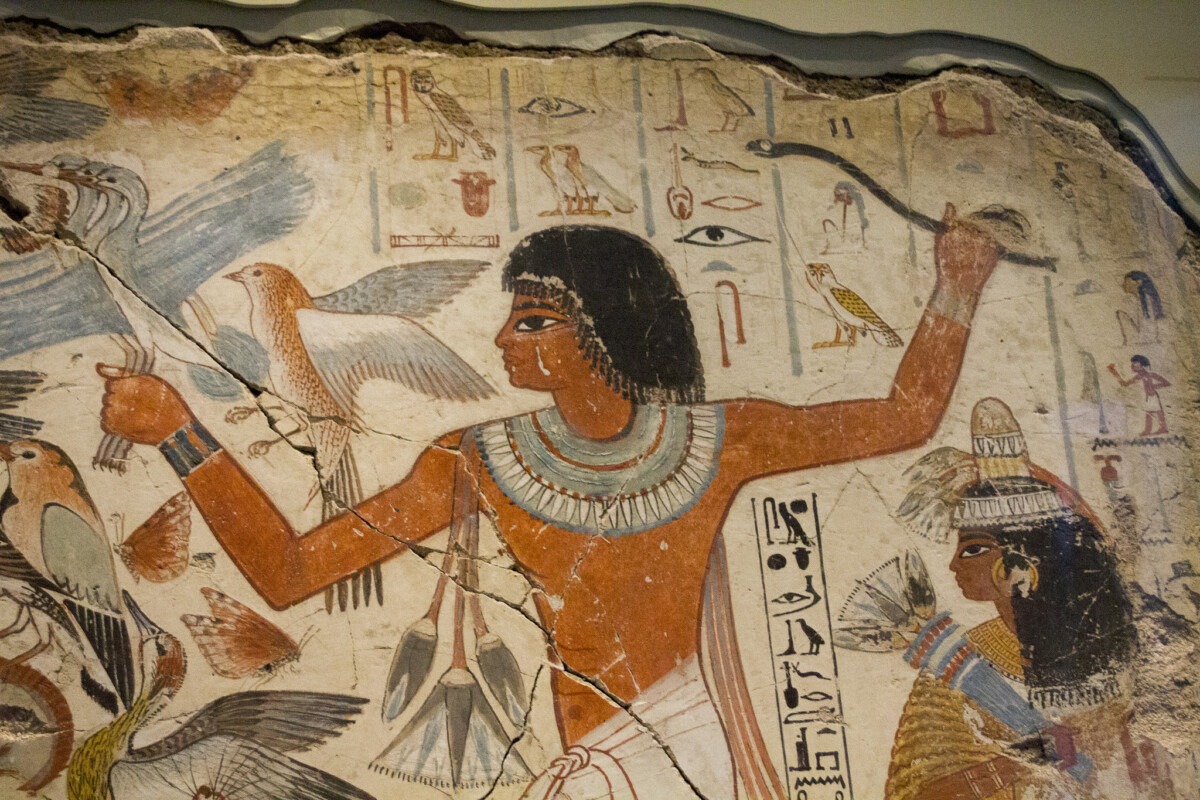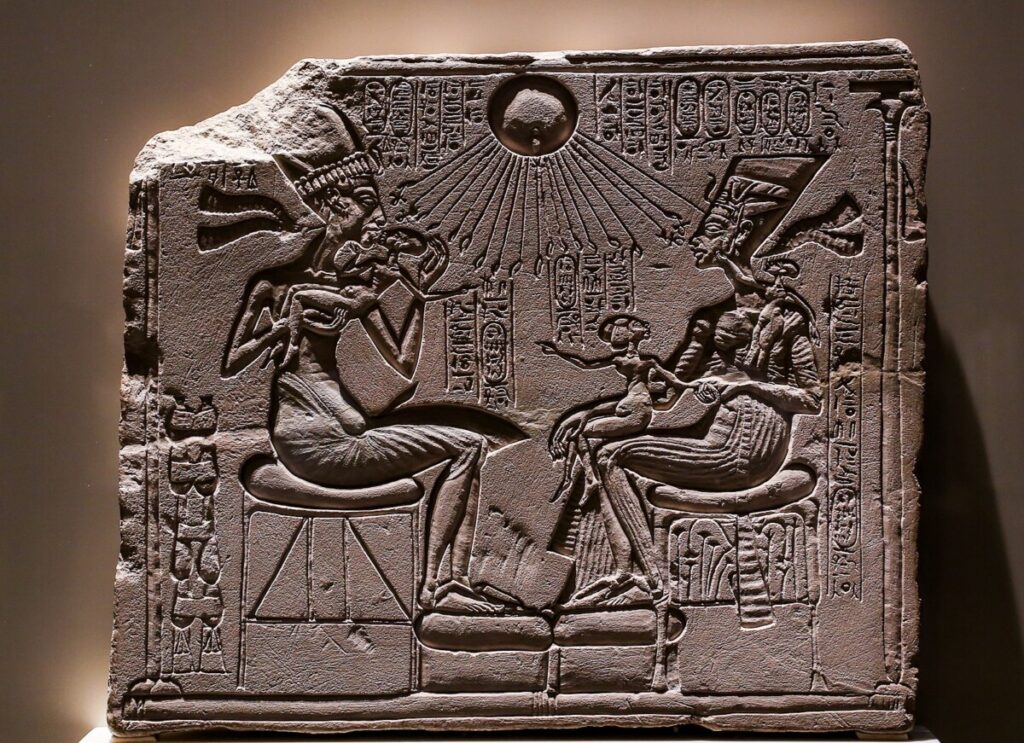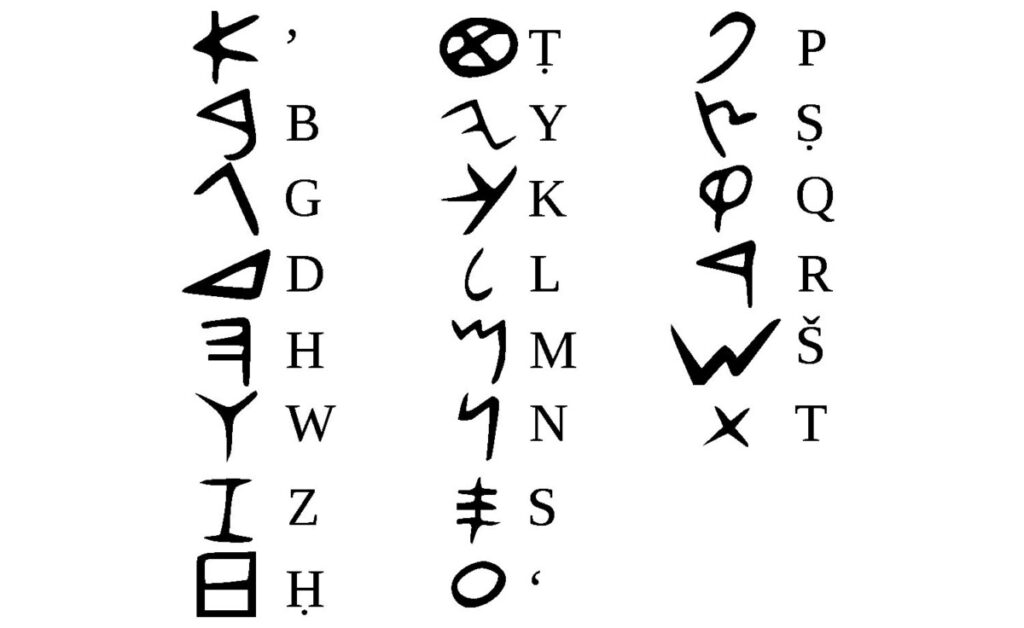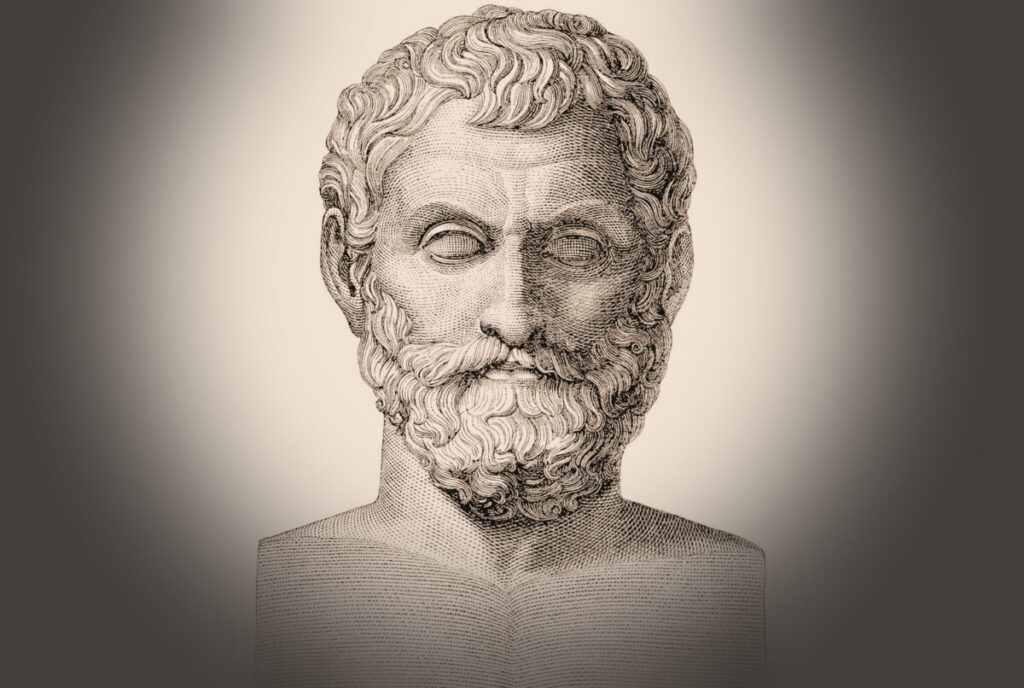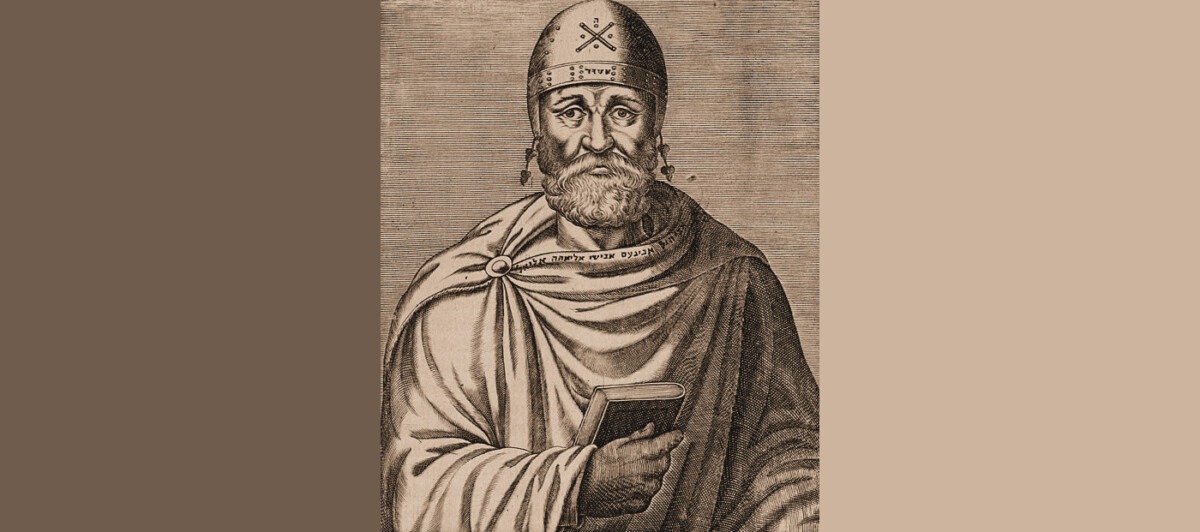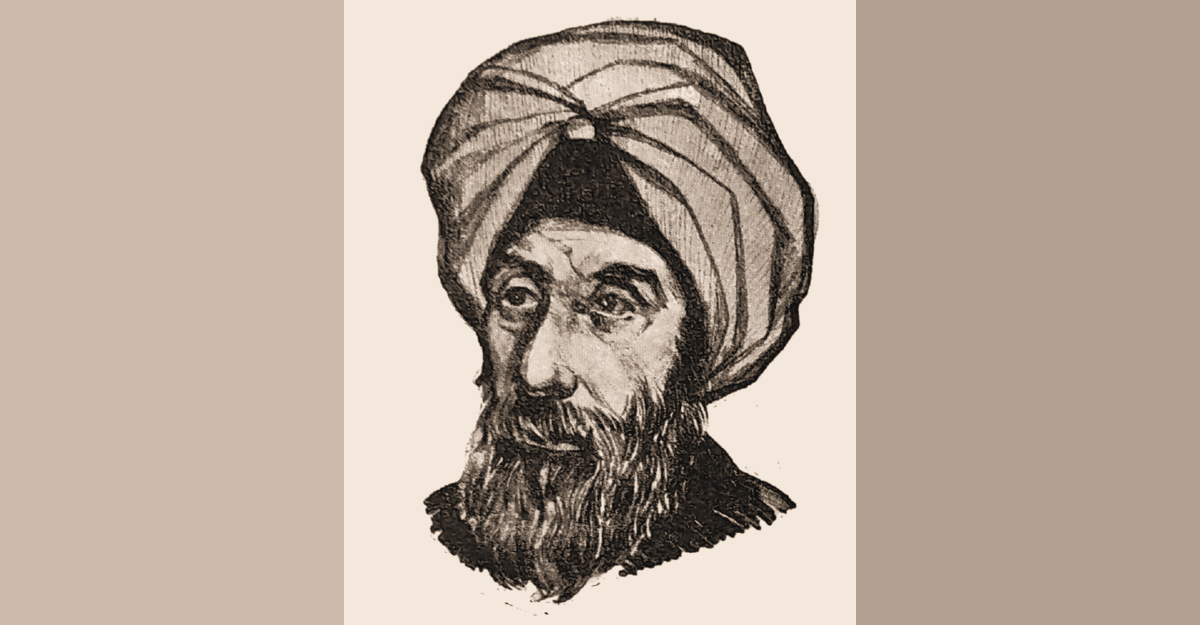Land TL: 1. Africa & Middle East | 2. The Americas | 3. Asia | 4. Europe-Mediterranean | 5. Oceana-Australasia
History by historical land mass is yet another wonderful lens into knowledge. These insights are the backbone to Mike‘s articles and his longer effort books. A part of his lifelong commitment to study. While they are not complete, they are useful.
History of the Lands: Africa & Middle East
The earliest known stone tools date back to at least 3.3 million years ago. They are identified by their purposeful flaking patterns, sharp edges, and location with other more identifiable artifacts or fossils. They are then verified with microscopic analysis confirming repetitive use.
Possible Stone-Tool Progression:
By 3.4 mya: Hammerstones, no modification, used for pounding seeds, nuts, or breaking bones.
By 3.3 mya: Lomekwi stone tools. Stone cores, rock flakes removed to reshape, narrow, or sharpen.
By 2.6 mya: Oldowan tools; first definite tools. Stone flakes with sharp edges would used for cutting meat, scraping hides, chopping plants, and wood whittling.
By 2.4 mya: Refinement of Oldowan tools, with more controlled flaking and sharper edges.
By 1.76 mya: Acheulean hand axes, iconic tools with a distinctive teardrop or oval shape for chopping wood, butchering animals, digging, and scraping.
By 1.76 mya: Larger cutting tools such as cleavers for butchering large animals, or heavy-duty scrapers for processing hides or wood.
By 500,000 ya: Middle Paleolithic tools, including pointed hand axes, side scrapers, knife-like tools, and awls for piercing.
By 300,000 ya: Diverse materials such as bone and antler start surviving the test of time. Earliest evidence of composite tools using multiple materials combined to produce tools with specific functions.
By 200,000 ya: Hafted tools, where stone tips are attached to wooden handles, significantly enhancing their effectiveness and range of use.
The Olduvai Gorge in Tanzania stands as a testament to early human ingenuity and foresight, illustrating a rudimentary form of organizational behavior that predates modern civilization. Utilized extensively over two million years, the site functioned akin to a “factory,” where early humans systematically crafted a variety of stone tools. They strategically selected specific locations that optimized their tool-making efforts. This specialization of space for specific activities suggests a significant cognitive leap—recognizing the efficiency of designated work areas. Such spatial organization reflects the emergence of complex thinking, where early humans not only made tools but also thought strategically about where to make them, hinting at the early development of proto-civilizational structures.
Analysis: Interestingly, remarkably few human remains have been directly associated with the primary tool-making areas. This separation implies that while the site was pivotal for tool production, other aspects of daily life, such as habitation and burial practices, occurred elsewhere. The diverse array of tools found at Olduvai, from simple Oldowan choppers to more advanced Acheulean hand axes, marks significant milestones in technological advancement. The absence of human remains, coupled with the diversity of artifacts, provides crucial insights into the early human capacity for planning, foresight, and possibly, social stratification.
By about 1.76 million BCE, early humans began to create hand axes. They would strike really large flakes, then continue to shape them around the edges. On the right, the hand axe pictured dates to circa 1.1 million BCE. It was found at Isampur, India.
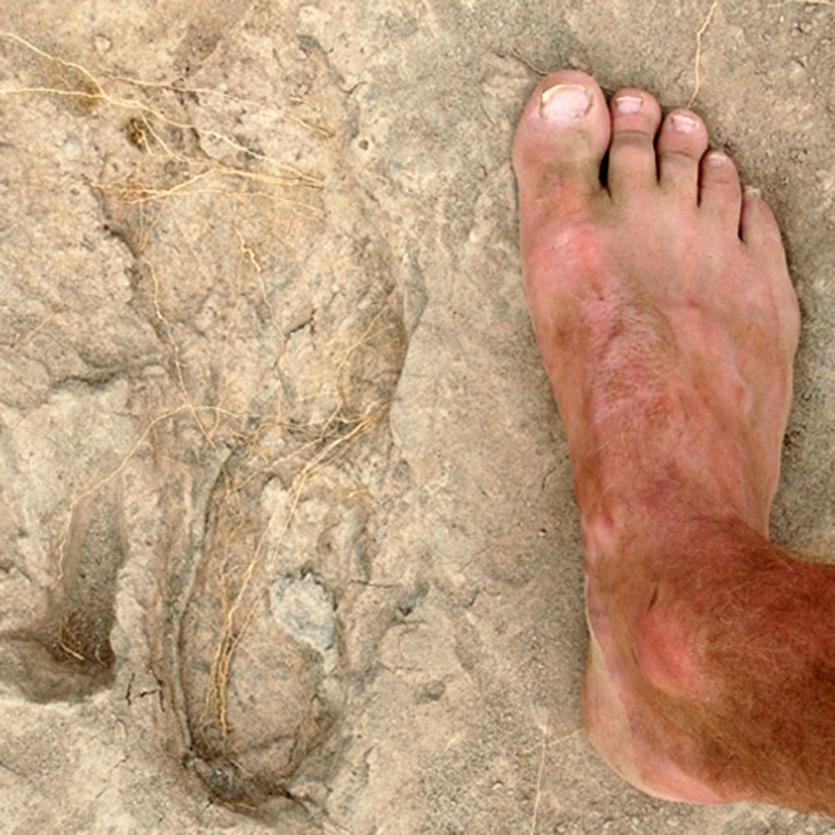




Species: Likely Homo erectus, our direct ancestor. The footprints found in Ileret, Kenya represent the oldest undisputed evidence of hominins walking upright in an efficient manner characteristic of modern humans. Our style of upright walking, which Homo erectus appears to have shared, is energy-efficient and adapted for long distances. It involves a long stride with a spring-like mechanism in the arch of the foot. These particular footprints demonstrate a well-developed arch and a long stride, culminating in a propulsive toe-off similar to us.
By this period, Homo erectus set a precedent for the locomotion seen in future hominin species, including Homo heidelbergensis, Neanderthals, Denisovans, and even the shorter Homo floresiensis.
Burned flint tools dated to circa 790,000 BCE were discovered at Gesher Benot Ya’aquov, Israel. Control of fire is one of the key traits of the genus Homo.
Other than humans, today’s smartest primates—chimpanzees, bonobos, gorillas, and orangutans—have a combined wild population of approximately 400,000 to 700,000. This number persists despite their near-complete inability to expand beyond their current ideal environments, a restriction not faced by any human species since before Homo habilis. Moreover, this is in spite of the extreme pressures exerted by various human species over the last 300,000 years. Drawing from this, the hominins of 700,000 BCE, including Homo erectus, Homo heidelbergensis, and other yet-to-be-discovered human species, might have had a global population ranging from 1.2 to 2.1 million. While highly speculative, this estimate is plausible, perhaps even conservative, considering Homo erectus‘ widespread presence and success across diverse environments in Africa and Eurasia. This era, significantly before the emergence of modern humans, showcases a dynamic tableau of early human life, marked by significant migrations and adaptations to varying ecological niches. Check out A New Look at Ancient Hominin Numbers: A Speculative Journey for more information.
Proto-clothing, encompassing basic garments such as animal skins and possibly decorative natural materials, likely emerged among hominins around 600,000 years ago, with Homo heidelbergensis being a probable early adopter. This species, experiencing diverse and often colder climates across Europe and Africa, may have utilized simple clothing as a practical response to environmental challenges.
Analysis: The evidence for early use of clothing, while direct only for Homo sapiens and Neanderthals around 100,000 years ago, can be inferred for earlier hominins through indirect markers. The Last Common Ancestor (LCA) of Neanderthals and modern humans, dating back approximately 600,000 years ago, introduces the possibility that simple forms of clothing might have been in use from this point forward. This assumption is based on the survival needs in varying climates and the sophistication of tool use seen in Homo heidelbergensis. Additionally, the emergence of Homo antecessor around 1.2 million years ago and the sophisticated behaviors observed in Homo erectus, suggest that the use of clothing could be reasonably extended back as far as 1.5 million years ago, albeit more speculatively. Conversely, earlier hominins such as Homo habilis, with their limited tool use and milder environmental conditions, likely did not develop clothing.
When Homo sapiens first emerged, their population in Africa was likely just a few hundred thousand, while the total hominin population, including other species like Neanderthals and Homo heidelbergensis, may have ranged from 1.1 to 2.1 million. During this period, Homo sapiens were primarily found in Africa, while other hominins occupied broader ranges across Eurasia, with Neanderthals and Denisovans adapting to their environments with sophisticated tool-use and social structures. The early hominin distribution and interaction remain unclear, and this narrative, while speculative, helps us imagine the ancient world, highlighting the need for caution in interpreting these ancient population dynamics. Check out A New Look at Ancient Hominin Numbers: A Speculative Journey for more information.
Homo heidelbergensis lived in Africa, Europe and Asia from 700,000 to 200,000 years ago. They coexisted with humans in Africa, Europe, and Asia from our emergence around 315,000 years ago until their extinction about 200,000 years ago.
Imagined Image: A Homo heidelbergensis campsite a few thousand years before they went extinct, set in a lush European forest. The scene includes several individuals in a communal setting, showcasing aspects of their life and environment.
Earliest known seasonal settlement in the Africa/Middle East zone: In the diverse and rich landscapes of what is now South Africa, the Klasies River Caves served as a vital seasonal haven for early modern humans.
Positioned strategically along the coast, these caves were revisited across generations, suggesting a shared understanding among different groups about the benefits of this location. The community constructed simple yet effective shelters from branches and animal hides just outside the cave entrances, creating a setup that supported daily activities such as tool crafting, hide preparation, and communal cooking over open fires.
This pattern of seasonal settlement allowed for the efficient exploitation of local resources, minimizing the need for constant movement and enabling a more sustainable living arrangement. It fostered not only survival but a thriving community life where knowledge, skills, and social bonds were developed and strengthened.
The archaeological remains and artifacts from the Klasies River Caves—ranging from sophisticated stone tools to evidence of hearths and human remains—illustrate a complex social structure that predates agricultural societies. These findings highlight the ability of early humans to adapt to their environment through cooperative behaviors and strategic planning, showcasing a level of communal life and environmental management that speaks to the enduring human spirit and intellectual vigor comparable to that of contemporary societies. This site provides a profound glimpse into one of humanity’s earliest known attempts at semi-permanent living, underscoring the sophisticated social dynamics that underpinned pre-agrarian human settlements.
Imagined Image: The image of the semi-nomadic people of South Africa depicts a group of up to 50 individuals congregating here around 100,000 years ago, establishing a semi-permanent settlement that utilized the natural shelter provided by the caves and the abundant resources of the surrounding area.
.
Circa 76,000 BCE someone in Africa, perhaps the child’s parents, carefully prepared a human child aged about three years old for burial. They dug a circular pit at the entrance to a cave (likely their cave), placed the child in the hole on his or her right side with knees drawn toward the chest.
After proper analysis of the surrounding soil and the decomposition that has taken place in the pit over the years, the archaeologists believe the child, now nicknamed Mtoto, was intentionally buried shortly after death.
Earliest known symbol use in the Africa/Middle East zone.
Located in South Africa, the cave contains engraved ochre pieces, which are among the earliest known forms of abstract art.
Cognitive Revolution
50,000 BCE – 70,000 BCE. Population range: 500,000 to 2.5 million.
Given the uncertainties and lack of direct data, the following are speculative estimates.
- Africa-Middle East: 50-60% or 600,000 to 1 million people
Africa, being the origin of modern humans, likely had the highest population density at this time, particularly in Sub-Saharan regions which were more conducive to human habitation due to their climate and available resources. - Asia: 40% or 200,000 to 400,000 people
- Europe-Mediterranean: 10% or 50,000 to 100,000 people
- The Americas: 0.
- Oceana-Australasia: 1% or 10,000 to 15,000 people
The initial colonization of Australia around 50,000 BCE by modern humans involved small, isolated groups who managed to navigate sea crossings, leading to a very low initial population density. The rest of the remote islands of Oceania were among the last to be reached by humans.
A Shared Earth! Neanderthals-Hobbits-Flourensis
Around this time, Homo sapiens shared the Earth with other hominin species. Neanderthals were still widespread in Europe and parts of western Asia. In Asia, particularly on the islands of Indonesia, Homo floresiensis, often referred to as the “Hobbit” due to their diminutive stature, survived until about 50,000 years ago. Additionally, Denisovans, a less visually documented but genetically distinct group, also roamed Eurasia, leaving behind a genetic legacy that persists in modern humans, particularly among populations in Melanesia.
The Lebombo Bone is one of the oldest known mathematical artifacts in human history. This ancient tool is a baboon fibula with 29 distinct notches carved into it. It was discovered in the Lebombo Mountains between South Africa and Swaziland. It was initially dated to approximately 35,000 years, but 24 radiocarbon tests since date it back about 44,000 years.
The Lebombo Bone was potentially used as a lunar phase counter or a simple tally stick. The series of notches may represent a lunar calendar, which would imply that early humans were tracking lunar phases for either ritualistic purposes or as a practical method for keeping time, possibly related to menstrual cycles or seasonal changes.
This artifact belongs to the Middle Stone Age, a period characterized by the development of more advanced stone tool technologies and the emergence of modern human behavior, including symbolic thought and perhaps early forms of arithmetic. The Lebombo Bone suggests that early humans engaged in complex thinking and had the capacity for abstract thought and planning.
The discovery of the Lebombo Bone and similar artifacts underscores the cognitive capabilities of early humans and their ability to use numerical concepts long before the development of written language or formal systems of numeration. This artifact, along with others like the Ishango Bone from Central Africa, indicates that the concept of counting and numerical recording was a part of human culture across different regions of Africa tens of thousands of years ago.
Since grain is easy to grow, does this suggest agriculture might have started a few thousand years earlier? Under study, but the discovery of bread-making from around 14,000 years ago indeed suggests that humans were experimenting with grains before the widespread adoption of agriculture, which is traditionally dated to about 12,000 years ago with the Neolithic Revolution.
In the shadow of history, nestled within the Black Desert of northeastern Jordan, lies the cradle of one of humanity’s most enduring culinary and cultural achievements: the invention of bread. Around 14,000 years ago, long before the dawn of agriculture and the domestication of cereal grains, the Natufian hunter-gatherers embarked on a gastronomic adventure that would forever change the course of human society.
Located in modern-day Syria, this is an important site because of the evidence demonstrating a likely pattern from hunter-gatherer to farming. It provides evidence of one of the earliest known villages. The leading interpretation is that they were settled in the area and practiced hunting and gathering before about 11,500 BCE. Around 11,500 BCE there is clear evidence of farming. While it’s likely they still hunted and perhaps gathered, it was around this time at least part of their food was from farming. This site provides insights into the transition from nomadic to settled life, showcasing early domestication of plants and permanent structures.
Late Stone Age
Mesolithic Period: 10,000 BCE – 6000 BCE.
- Africa-Middle East: 30% or 1.2 million peopleg
- Asia: 40% or 1.6 million people
- Europe-Mediterranean: 15% or 600 thousand people
- The Americas: 10% or 400 thousand people
- Oceana-Australasia: 5% or 200 thousand people
Located in modern-day Turkey, Göbekli Tepe is one of the world’s oldest known temples. This site features massive carved stones and complex architectural structures that predate Stonehenge by some 6,000 years. The sophistication and scale of Göbekli Tepe suggest that the community was able to coordinate large-scale projects, indicating a high level of social organization and spiritual or communal life. Without evidence of permanent residential structures from this site, these people were more likely hunter-gatherers that stuck to the area, and not farmers.
Earliest known permanent settlement in the Africa/Middle East zone.
Jericho, located in the West Bank, Palestinian Territories, stands as one of the earliest known permanent settlements in the Africa/Middle East zone, with continuous habitation dating back to at least the 9th millennium BCE. Situated near an oasis in the Jordan Valley, Jericho’s strategic location provided access to vital water sources, facilitating agriculture and sustaining human settlement.
Permanent Settlement Note: This early permanence challenges traditional notions of settlement patterns, showcasing the importance of water in the establishment of communities. It’s worth noting that while Jericho is among the earliest known permanent settlements, there may be even earlier settlements nestled along lakeshores or rivers, but their discovery is hindered by the very element that made them attractive to ancient peoples: water.
The earliest known use of plaster dates back to around 9000 BCE, with evidence from the ancient site of Çatalhöyük in modern-day Turkey. Here, Neolithic inhabitants utilized plaster made from lime to coat the floors, walls, and even ceilings of their mud-brick houses. This early application of plaster represents a significant technological innovation, indicating a sophisticated understanding of construction materials and their protective and aesthetic properties. The use of plaster enhanced the durability and appearance of architectural structures and had practical health benefits, such as preventing infestations and regulating indoor climates.
Earliest known agrarian society in the Africa/Middle East zone: Located in southern Egypt, Nabta Playa is one of the earliest known agrarian societies in the Sahara. This prehistoric community developed a sophisticated system of cattle herding and possibly small-scale cultivation, alongside seasonal water management strategies, making it a precursor to more complex agricultural societies in the Nile Valley.
Imagined Image: The image of the semi-nomadic Nabta Playa around 7400 BCE depicts a semi-arid landscape with sparse vegetation, where early inhabitants manage small herds of cattle and engage in rudimentary agriculture. Simple stone structures and megalithic arrangements suggest the beginnings of organized social and ritual practices in a seasonally used settlement.
The Ain Ghazal statues, dating back to around 7200 BCE, are among the earliest known examples of human figures crafted from plaster, highlighting an advanced use of materials in the Neolithic period. This technique involved applying plaster, made from lime and powdered limestone, over a core of reeds and twine to create lifelike statues with detailed facial features and expressive eyes made from bitumen. The use of plaster for such artistic and possibly ritualistic purposes at Ain Ghazal predates many other known uses of the material in sculpture. While plaster had been used in simple construction and repair tasks even earlier, the sophisticated application at Ain Ghazal marks a significant development in the artistic capabilities of Neolithic societies.
The city of Çatalhöyük was a very large Neolithic city in the southern Anatolia peninsula in modern day Turkey. The population of 5,000 to 10,000 lived in mudbrick buildings. Some of the larger buildings have ornate murals. A painting of the village, with the twin mountain peaks in the background is frequently cited as the world’s oldest map, and the first landscape painting.
No sidewalks nor streets were used between the dwellings. The clustered honeycomb-like maze of dwellings were accessed by holes in the ceiling and by doors on the side of houses. The doors were accessed by ladders and stairs. The rooftops were effectively streets. I can imagine on good whether days the rooftop of the massive honeycomb building was similar to a Roman forum some 5,000 years in the future–a place to meet, socialize, and perform business.
Who drank the first beer? Getting buzzed definitely has very deep historical roots. The earliest evidence of any fermented beverage is fruit-based, aka wine, and comes from the Jiahu site in China and dates back to around 7,000 BCE (9,000 years ago). In addition to fermented beverage residue in China, we have grain-based, aka beer/ale, residue in pottery going back to 5000 BCE in the Middle East, 4000 BCE in Europe, but it’s the Sumerians that wrote down the earliest known beer recipe in 1800 BCE. Go Sumerians! Before all this, it’s a mystery awaiting discovery, but we know chimpanzees pick up rotting fermented fruit on the jungle floor to get drunk, pushing potential roots back 7.5 million years to our common ancestor.
Atlit Yam is a captivating ghost town submerged beneath the Mediterranean Sea off the coast of Israel. This ancient Neolithic village, dating back over 9,000 years, offers a unique window into the lives of these coastal inhabitants. Abandoned in a hurry, the site was left with many belongings and food sources still intact, offering a unique glimpse into the lives of its ancient inhabitants. Preserved by the watery tomb, the site reveals a vibrant community that thrived around 6900 to 6300 BCE, relying on both land and sea. Archaeologists have uncovered well-preserved houses, tools, and even human remains, painting a vivid picture of daily life in this prehistoric settlement.
While no writing was found, the site has yielded various forms of art and symbolic expression including geometric stone tiles, carved stone figurines, rock art, and personal adornments.
- Under sea preservation: unique and well-preserved finds.
- Copper artifacts (early metalworking)
- Oldest known cases of tuberculosis.
- Elaborate ritual structures
- Sophisticated water management systems (including a freshwater well)
- advanced social structure
- advanced technology for the time
From 6500 to 4000 BCE, the Sumer civilization increased in social polarization. For example, central houses in the settlements became bigger. This early Sumer culture is characterized by large unwalled villages with multi-roomed rectangular mud-brick houses. The village featured public buildings including temples and centralized government. They had fine quality greenish colored pottery decorated with geometric designs in brown or black paint. Their known tools that survived the test of time included sickles made of hard fired clay, stone, and metal and the use of ploughs. Villages included craftspeople, potters, weavers and metalworkers, but the bulk of the population were farm workers.
The known Sumerian city-states written history goes back to before 2700 BCE, and starting about 2300 BCE the records are fairly complete.
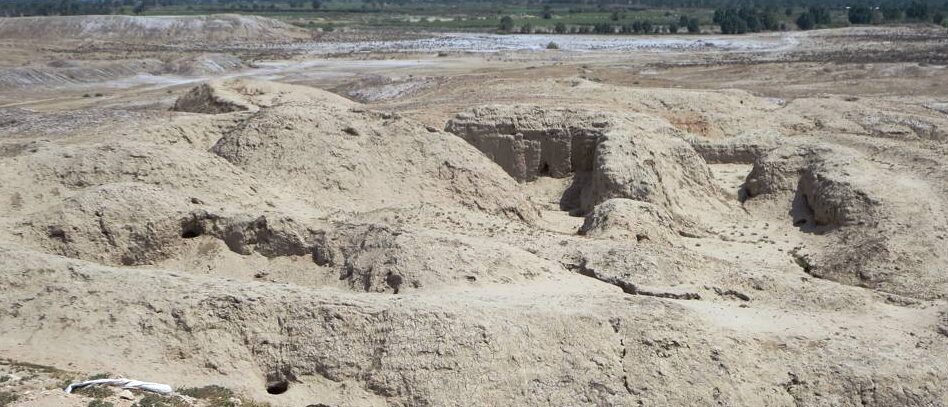
Interpreting the date God created the Earth by reading and interpreting the Bible is very difficult. You can put dates on events, time between events, etc. then convert it to the modern Julian calendar. One popular interpretation is Sunday, October 23, 4004 BCE. Generating this date, and similar, rely on the Ussher chronology technique. The Ussher chronology technique comes from the 17th-century Archbishop James Ussher. Ussher created a chronology of the history of the world formulated from a literal reading of the Old Testament. Updates and various interpretations along the same lines are frequently lumped under Ussher chronology.
Others not specified.
- Islam: No creation date implied.
- Chinese mythology: No creation date implied, early time is more symbolic.
- Ancient Egyptian: No creation date implied, early time is more symbolic.
The earliest known man made glass dates back to circa 3500 BCE and to Egypt and Eastern Mesopotamia. Discovery of glassblowing around 1st century BC was a major breakthrough in glass making.
Earliest known writing in Africa/Middle East zone.
Human DNA today is the same as 50,000 BCE. There is no doubt there were many dozens and perhaps thousands of civilizations prior to the Sumer civilization, but Sumer is the earliest known, or at least the earliest well known. The Sumer civilization first established between 6500 and 4100 BCE. We know quite a bit about the Sumerians because they immortalized their writing in clay tablets which will be around long after all the paper books on Earth right now have deteriorated. Sadly, we know almost nothing about prior civilizations because very little evidence survived the test of time. The Sumerians spoke and wrote Sumer and starting several millennia into their civilization they started immortalizing their culture on clay. They had an advanced democracy with elected officials, religion, art, wheel, math, philosophy, and language. The Cuneiform script was in use until 100 CE.
The oldest known dice date back to around 3100 BCE in Scotland. While it’s possible the idea of dice was invented many millennia ago, it’s more likely that dice are an example of convergent invention and traveling news. Dice were likely invented and lost to the sands of time many times over at least the last 100,000 years.
The earliest known dice so far were bone dice found at the site of the Neolithic village of Skara Brae in Orkney, Scotland. They were used sometime between 3100 and 2400 BCE. The dice have been decorated with combinations of notches, grooves, and dots (pictured above). This settlement was buried in sand, thus preserving buildings and a range of everyday objects. The inhabitants used bone and antler as a raw material for a range of objects including shovels, awls, pins, knives, and even beads.
In the Mesopotamian region, the oldest known dice date back to around 3000 BCE. They were found in the Burnt City (Shahr-e Sukhteh) in Iran. These ancient dice were made from various materials like bone and stone, and they have been found in association with other early gaming artifacts.
Within four centuries, news of this entertainment traveled east 750 miles to the Indus Valley Civilization, navigating harsh landscapes, political, and social barriers. The Indus Valley dice date back to about 2600 BCE. The evidence suggests that dice were in wide use in multiple areas for at least centuries and likely for millennia. Either way, from here, news of dice would take about two millennia to reach distant places like China. Asian dice date back to about 600 BCE. It’s also possible that dice in China were invented separately as another example of convergent invention.
Stone Copper Age
Chalcolithic Period: 3,000 BCE – 500 BCE.
- Africa-Middle East: 36% or 5 million people
Early civilizations include Egypt and Mesopotamia with a relatively higher population density. - Asia: 36% or 5 million people
Early civilizations include Indus Valley and ancient China. They saw early urban development and agriculture which supported larger populations. - Europe-Mediterranean: 14% or 2 million people
Smaller due to the varied climatic conditions and the later development of agriculture compared to the Middle East. - The Americas: 7% or 1 million people
More sparsely populated with many diverse hunter-gatherer communities and early agricultural societies, particularly in regions like Mesoamerica. - Oceana-Australasia: 7% or 1 million people
These regions were among the least densely populated, with scattered tribal groups primarily leading hunter-gatherer lifestyles.
The Fuente Magna Bowl, discovered in 1950 near Lake Titicaca, Bolivia, is a large stone vessel with intricate carvings. Unearthed by a local farmer, the bowl was later donated to a small local museum and eventually transferred to the Museum of Precious Metals in La Paz. The bowl features engravings that some claim resemble ancient Sumerian cuneiform and other proto-scripts. This artifact’s intricate carvings have sparked significant interest due to their apparent similarity to writing systems used thousands of miles away in ancient Mesopotamia.
It might be a modern forgery, but if not, the Fuente Magna Bowl is significant because it might point to a Sumerian-South America connection or to earlier proto-writing. Experts like Dr. Clyde Ahmed Winters have proposed that the inscriptions are Proto-Sumerian, suggesting possible ancient transoceanic contact. However, many scholars are skeptical, citing inconsistencies in the script and questioning the bowl’s provenance. Some suggest that the markings might hint at an earlier form of writing, indicating a longer and more complex path to the development of written language than currently understood. This possibility could have profound implications, suggesting that the origins of writing might be more widespread and interconnected than previously thought.
Gilgamesh is the legendary figure whose exploits are immortalized in the “Epic of Gilgamesh.” Gilgamesh’s reign as king is shrouded in myth and history. The epic describes his journey from a tyrannical ruler to a wise and beloved king, highlighting his quest for immortality and the profound friendship with Enkidu, a wild man created by the gods to temper Gilgamesh’s arrogance. Through his adventures, which include battling monsters and seeking eternal life, Gilgamesh learns about the limits of human power and the inevitability of death. The tale, etched on clay tablets, is one of the earliest known literary works.
30 Phil, Chapter 2: Shuruppak and Paternal Wisdom
Sumerian civilization consisted of over 30 city-states, among which Ur and Shuruppak were among the more prominent. We know about King Shuruppak from the Sumerian King List, an ancient text where he appears as the last king before a great flood. Although the list mixes historical kings with mythical figures, it places him at about 2600 BCE. King Shuruppak, circa 2625 BCE to 2550 BCE. Author of the “Instructions of Shuruppak.” It comes to us from around 2600 BCE, perhaps a century or so after the time of Gilgamesh. It is one of the oldest surviving works of literature in the world. This fatherly advice provides valuable insights into his views, and a glimpse into Sumerian philosophy, which is why he’s the first philosopher, the first chapter anchor, of “30 Philosophers.”
My favorite sayings:
- Be loyal and faithful to your friends, they are a source of support.
- Do not cheat or deceive others, for it is a breach of trust.
- Do not be envious of others, for it leads to bitterness.
- Be diligent in your work, for it brings success.
- You should not pass judgment when you drink beer.
Pictured is the Ziggurat of Ur, about 70 miles from Shuruppak. The city of Shuruppak had a similar one.
17,000 fragments totally maybe 2,500 tablets, discoved in the 1970s, only a few hundred have been translated.
The library of Ebla, located in the ancient city of the same name was located in modern-day Syria. This library dates back to the 24th century BCE and contained thousands of clay tablets written in Sumerian and Eblaite, providing a wealth of information about the culture, economy, and administration of Ebla. These tablets were discovered in the 1970s and offered significant insights into the early periods of human writing and civilization. The Ebla library predates other famous ancient libraries, such as the library of Ashurbanipal in Nineveh and the Library of Alexandria, showcasing the deep historical roots of library institutions as centers of knowledge and record-keeping.
The legendary story of Noah’s flood occurred in the year 2348 BCE if you believe Ussher’s biblical timeline he made up in 1654. However, this flood myth is clearly based on the Sumerian flood story documented in the Epoch of Gilgamesh circa 2100 BCE.
The Epoch of Gilgamesh is regarded as one of the earliest surviving notable literature. I think it is interesting to note that the first section of the Epoch of Gilgamesh refers to a time span of 241,200 years prior to the great flood. To me, it is interesting that around the proposed date of the great flood, the people authoring it thought the Earth was at least 241,200 years old. The first section of the Epoch of Gilgamesh lists eight kings who ruled over the five cities of Eridu, Bad-tibiru, Larag, Zimbir and Shuruppag. The section ends with the line “Then the flood swept over.”
The Proto-Sinaitic alphabet is considered the earliest trace of alphabetic writing and the common ancestor of both Ancient South Arabian script and the Phoenician alphabet. The ancient South Arabian script evolved about 900 BCE which continued to evolve into today’s Modern South Arabian languages. The Phoenician alphabet evolved into the Greek alphabet and all of today’s Western alphabets.
A set of about 300 legal laws written in stone from ancient Near East that withstood the test of time. Hammurabi, the sixth king of the First Dynasty of Babylonian, wrote it in cuneiform in the Old Babylonion dialect of Akkadian. The text itself was copied and studied by Mesopotamian scribes for over a millennium.
Translated examples:
- If a man should blind the eye of another man, they shall blind his eye.
- If a man bears false witness in a case, or does not establish the testimony that he has given, if that case is case involving life, that man shall be put to death.
- If a man bears false witness concerning grain or money, he shall himself bear the penalty imposed in the case.
The Tomb of Nebamun, located in Thebes, Egypt, contains some of the most famous and vibrant frescoes from the 18th Dynasty of the New Kingdom period. The paintings depict Nebamun, an Egyptian official, engaging in various activities, including hunting in the marshes and enjoying banquets with his family. The frescoes are celebrated for their dynamic compositions, detailed portrayal of figures and animals, and the use of color, which brings the scenes to life with remarkable vitality. These works not only exemplify the artistic skills of ancient Egyptian painters but also offer a glimpse into the values, leisure activities, and beliefs of the period.
In the ninth year of the reign of Akhenaten, he declared the traditional supreme God Aten to be the only God of Egypt with himself as the sole communicator to Aten, kind of like an early Pope. This early attempt at monotheism failed after about 20 years and Egypt returned to their traditional polytheistic religion.
About the image: Akhenaton and Nefertiti seated, holding 3 of their daughters, under the rays of the sun god Aten giving Ankh-symbols to them (Picture provided by ArchaiOptix).
The Phoenician alphabet is a direct continuation of the Proto-Canaanite script circa 1300 BCE. Starting about 900 BCE, the Phoenician alphabet thrived and was adapted by others. It evolved into use by many languages including Greek, Old Italic and Anatolian scripts. These early uses of the alphabet evolved into the alphanumeric alphabet.
Thales of Miletus was a Greek philosopher, mathematician, and astronomer. Considered by many including Aristotle to be the first philosopher in the Greek tradition. He is also considered the father of science by many.
Some of my favorite translated sayings are:
- Know thyself.
- A multitude of words is no proof of a prudent mind.
The Library of Ashurbanipal, established during the reign of Ashurbanipal (668–627 BCE), the last great king of the Neo-Assyrian Empire, is one of the most significant collections of ancient texts. Located in Nineveh, the capital of Assyria, this library housed thousands of clay tablets inscribed with cuneiform script, covering a wide range of subjects including literature, history, science, and law. The most famous work found in this collection is the “Epic of Gilgamesh.” Ashurbanipal, a scholar-king, collected texts from across his empire and beyond, aiming to preserve the knowledge and culture of Mesopotamia. The library’s discovery in the mid-19th century provided invaluable insights into the civilization of ancient Mesopotamia, making it a cornerstone in the study of ancient Near Eastern history.
30 Phil, Chapter 12: Philo and Abrahamic Philosophy
Philo of Alexandria, was born in the dynamic environment before the split of Judaism and Christianity. He was born around the year 20 BCE and became an important Jewish leader delving into the enigmatic world of Hellenistic Jewish religion.
Pictured: Portrait from 1500s. He likely did not look like this.
30 Phil, Chapter 15: Augustine, Time, and War
Augustine is known as the father of Western religious scholarship. He reconciled the science and philosophy of Aristotle with church beliefs.
- The world is a book and those who do not travel read only one page.
- Right is right even if no one is doing it; wrong is wrong even if everyone is doing it.
- There is no saint without a past, no sinner without a future.
30 Phil, Chapter 16: Al-Farabi and Intellect
Al-Farabi was born along the Silk Road circa 872 CE in the city of Farab, in present-day Kazakhstan. Al-Farabi’ thought was rooted in Platonic and Aristotelian frameworks, yet it seamlessly wove in elements of Islamic thinking. He imagined an ideal society, steered by virtuous leaders akin to Plato’s philosopher-kings, guiding them towards a virtuous existence. In his vision, true wisdom was the foundation of an intellectual civilization.
Pictured: Artist impression.
30 Phil, Chapter 17: Alhazen and the Senses
Alhazen was born in Basra around 965 CE, a city located in present-day Iraq. In his 30s, Alhazen faced the challenge of his life. He was “commissioned” to produce a solution for regulating the unpredictable and deadly flooding of the Nile. As he delved into the problem, it became clear the task was impossible. The “emission theory,” the prevalent theory before Alhazen, asserted that light originates from your eyes, hits objects, and is then reflected back. In “Book of Optics,” he explored aspects of vision and light, including reflection and refraction. He disproved the emission theory and proved the intromission theory.
Pictured: Artist impression.
In 1975, Italian archaeologist Paolo Matthiae and his team unearthed the remarkable Library of Ebla at Tell Mardikh, Syria, revealing a trove of around 20,000 clay tablets and fragments. This discovery dramatically expanded our understanding of ancient Near Eastern civilizations, introducing Eblaite as a previously unknown Semitic language and providing unprecedented insights into the culture, economy, politics, and diplomatic relations of Ebla. The tablets’ contents, ranging from administrative records to diplomatic correspondence and literary texts, have offered scholars a unique window into the early Bronze Age, highlighting the sophistication and interconnectedness of ancient societies. The rediscovery of the Ebla library stands as a milestone in archaeological and historical scholarship, underscoring the complexity of human civilization in the third millennium BCE.
Next >>
Land TL: 1. Africa & Middle East | 2. The Americas | 3. Asia | 4. Europe-Mediterranean | 5. Oceana-Australasia



